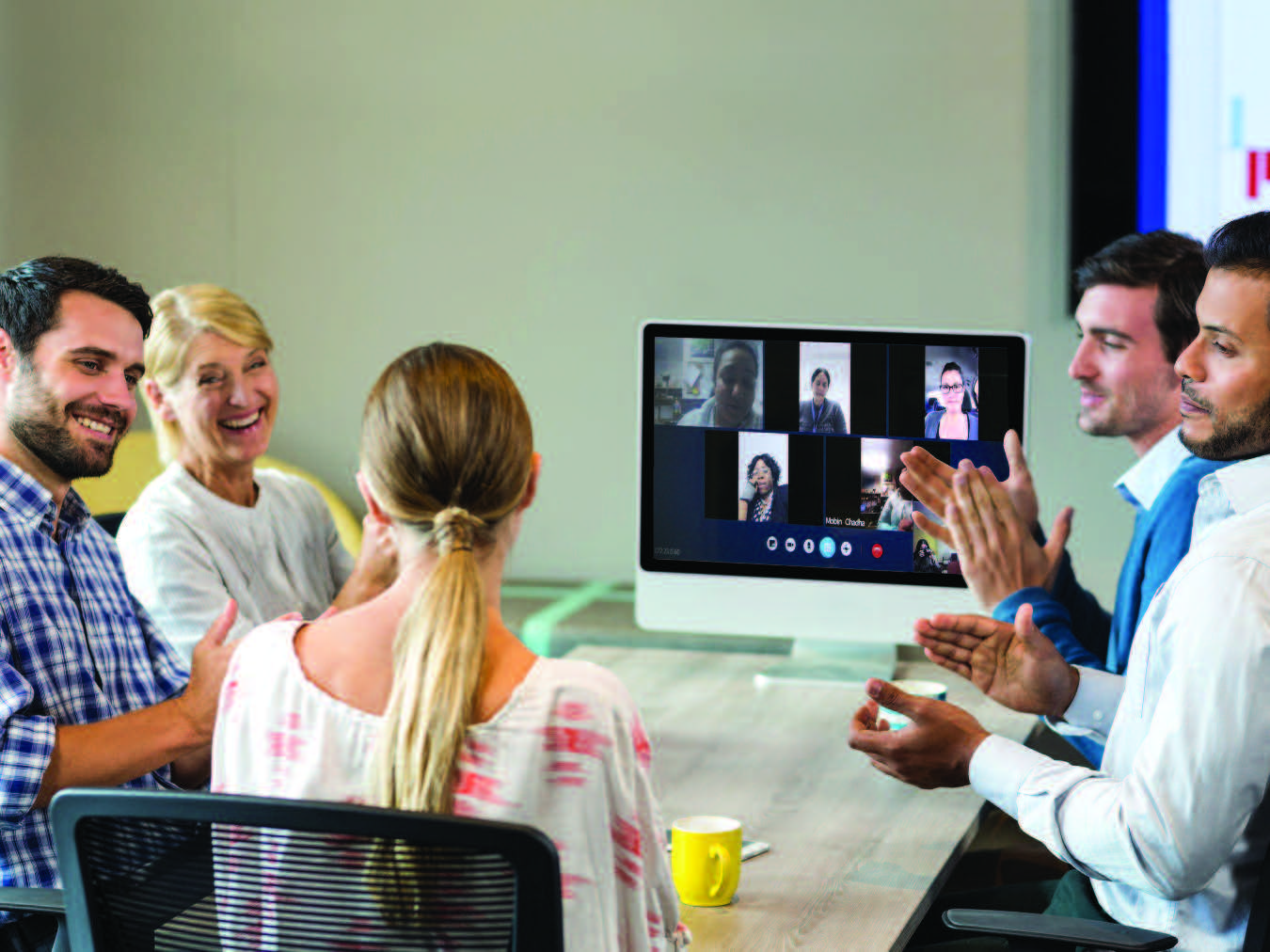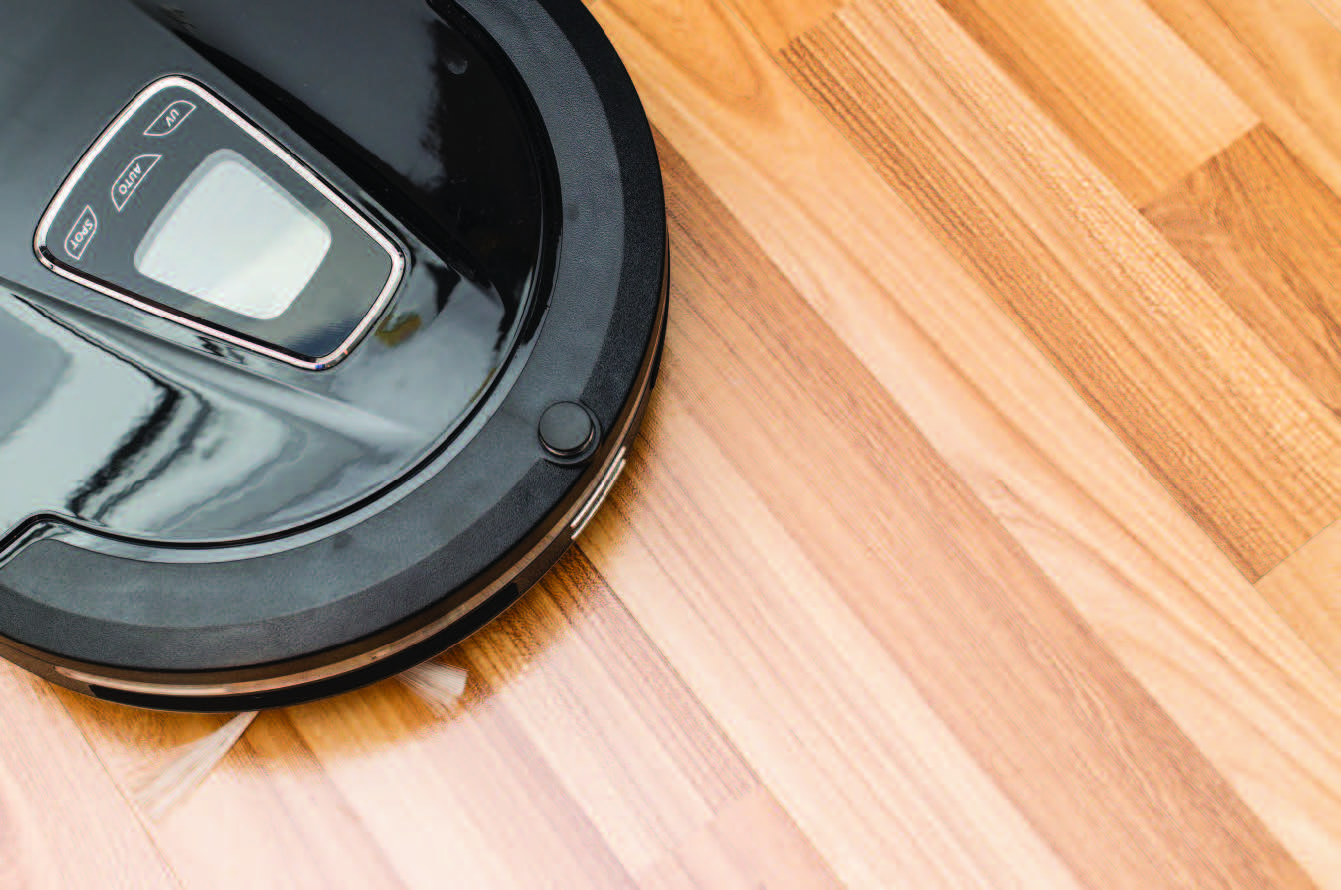By serving the underserved, Trinitas helps promote the power of pink.
By Christine Gibbs
In 1977, Susan Goodman Komen was diagnosed with breast cancer at the age of 33. She died three years later. Her younger sister, Nancy Goodman Brinker, in honoring a promise made to Susan to promote the fight against breast cancer, fulfilled that vow by starting a foundation in her sister’s name, in 1982. Later the name was changed to Susan G. Komen for the Cure with the ambitious goal to end breast cancer forever. Today, the organization is often simply referred to as Susan G. Komen or simply Komen. More than 100,000 volunteers work at the more than 120 Komen affiliates active in more than 18,000 communities across the country—which have awarded more than $93 million in community grants to bring needs-based screening and treatment resources to women most in need of them. In addition to the generous grants, Komen invests tens of millions of dollars to further ongoing research.
Nearer to home, one of the Komen Affiliates—Susan G. Komen of North Jersey—has just celebrated the 20th year of its dedication to fulfilling the national organization’s mission. As part of the network of Komen affiliates, Komen North Jersey has awarded more than $16 million in community grants to qualifying non-profit organizations in their nine-county territory. Among them is Trinitas Regional Medical Center, which has received a total of more than $1 million in grants.
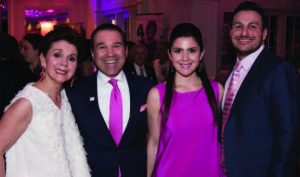
Deborah Q. Belfatto (left), with husband Joseph, daughter Lindsay Tabani and son-in-law Marcus Tabani.
In early April of this year, the Affiliate hosted its signature Pink Tie event, honoring its original founders, Deborah Q. Belfatto, Lisa Herschli and Kathy Hubert-McKenna. As a breast cancer survivor, Belfatto—founder and former Executive Director of Komen North Jersey—takes their responsibilities very personally and very seriously. Belfatto worked tirelessly to establish a Komen Affiliate in North Jersey after learning that 75% of all money raised would stay local. She says she became “hooked on the Komen formula” as a perfect fit for the greater North Jersey area.
Why Trinitas? Belfatto recognized the medical center’s dedication to “serving the underserved.” Trinitas, she adds, over the years has continued to over-deliver on its services to a blended population relative to their grant promises.
The TRMC Commitment
Trinitas provides one-stop breast cancer resources through its Women’s Imaging Center, a $3.8 million investment in radiologic imaging. Included among the services are FDA-approved low-dose mammography, minimally invasive stereotactic breast imaging, and ultrasound-guided aspiration/biopsy. The emphasis at Trinitas is to extend much-needed help to women with limited or no resources in getting through their battles with breast cancer. Given that their missions are so closely aligned, the Trinitas/Komen partnering has flourished for almost 16 years. Their ongoing relationship is a tribute to the Komen belief in the value of networking and partnership within the local community.
Much has changed since Belfatto first got involved in the fight against breast cancer. Back in the 1980s, she recalls, treatment was a “one-size-fits-all” approach. Thankfully today, treatment regimens are highly personalized and more specific to particular cancers. As a result, the survival rate for breast cancer has improved dramatically—although sadly 1 out of every 8 women in her lifetime in the U.S. will still confront a breast cancer diagnosis. Progress has been made, but much work remains to be done. As for her approach to the Komen cause and to life in general, Belfatto sums it up in four words: persistence, perseverance, passion and patience. And she never takes No for an answer.
In recognition of Deb Belfatto’s participation in the grant review process of Komen North Jersey—and her continued support of Trinitas as a consistently worthy grantee—she was invited to join the Trinitas Health Foundation Board in 2013. She reciprocated by extending her own ultimate compliment in noting that Trinitas is “one of the most selfless hospitals with whom I have ever worked.”
Event Horizon
Kathi Edelson Wolder. Who heads up Marketing and PR for Komen North Jersey, is another example of a totally committed member of the Komen support network. She was recently named a Komen Angel and her portrait hangs in the gallery of Komen’s Journey of Courage. Wolder parlayed her professional marketing experience into furthering the success of Komen North Jersey affiliate events. Most recently, she was instrumental in marking the 20th anniversary celebration of Komen North Jersey with one of the most successful “Pink Tie” gala celebrations. Starting in 1997, there have been 16 Pink Tie Balls that have contributed to the total $23 million that Komen North Jersey has invested in lifesaving research and local community grants. The most successful affair was sponsored in 2005 by Continental Airlines and held in Newark Airport—with 1,400 guests attending and $2.1 million raised. Wolder and Belfatto say it was “magical, like make-believe in the glory days” of formal extravaganzas.
Recently, the Pink Tie Ball underwent a name change. It is now known as the Pink Tie Party. The younger generation is less formal, Wolder explains, although pink bow ties were as always the neckwear of choice on the dance floor. She is busy focusing on helping to cultivate “a new regime” among the up-and-coming younger generation, who bring the limitless possibilities of the digital age to the Komen communication and publicity efforts. Whether it’s called a “ball” or a “party,” a fun atmosphere prevails and successful fundraising is accomplished. The latest event was attended by almost 500 supporters and grossed $500,000, which will soon be put to good use through Komen grants.
What powers the efforts of Belfatto and Wolder? Their belief in the future of the fight against breast cancer through the support of what they have labeled “Merging of the Ages”—i.e., young and energized Gen-X and Millennial supporters. Belfatto says it’s like being “surrounded by rock stars in the breast cancer community.” EDGE
Editor’s Note: Nothing makes Deb and Kathi happier or more hopeful about keeping the movement strong than to look into the faces of the future within Komen North Jersey and beyond. They continue to encourage survivors and co-survivors of all ages to continue their support of Susan G. Komen North Jersey and its events, including the Race for the Cure, which takes place each May.
MILESTONES
1969 Mammogram invented
1980 Susan G. Komen dies at age 36
1982 Nancy Brinker establishes the Susan G. Komen Breast Cancer Foundation
1984 Nancy Brinker is diagnosed with breast cancer and survives
1986 First Breast Cancer Awareness Month
1991 Komen pink ribbon becomes national symbol
1995 Race for the Cure events are held in 57 U.S. cities
2002 More than 1.3 million participate in 100 Race for the Cure events worldwide
2008 25th anniversary of Race for the Cure
2017 More than 3.1 million breast cancer survivors in the US today
2026 Target date to reduce deaths by breast cancer by 50%
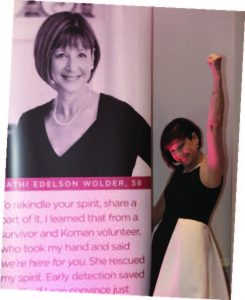 TAKING NOTHING FOR GRANTED
TAKING NOTHING FOR GRANTED
Komen North Jersey works with professionals and community leaders to perform a comprehensive needs assessment, the Community Profile, every 5 years as the basis for grant application. Funds awarded from Komen grants are restricted in that the money must be used to provide vital breast health services and treatments and are never comingled with general operating funds.
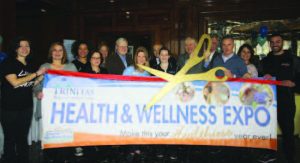 2017 TRINITAS HEALTH AND WELLNESS EXPO
2017 TRINITAS HEALTH AND WELLNESS EXPO
The 2017 Trinitas Health and Wellness Expo was held on Sunday, February 26th at Pantagis Renaissance in Scotch Plains, with over 500 people in attendance. Guests enjoyed demonstrations, resources, and some great presentations by experts on a variety of topics from stroke prevention to healthy dietary guidelines to follow. Ben Michaelis, Ph.D., author of Your Next Big Thing, and regular feature on The Today Show, Fox News and MSNBC, was the keynote speaker and focused on mental health and well-being through creative expression. The Expo was a collaborative effort with the Greater Westfield Area Chamber of Commerce, which aims to connect local businesses with the community.
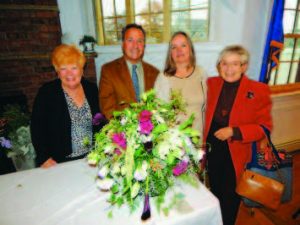 A VICTORIAN SPRING
A VICTORIAN SPRING
A Victorian themed flower show will be presented by the Rake and Hoe Garden Club of Westfield on April 28, 2017 from 1:00 to 7:00 pm at the Presbyterian Church on 140 Mountain Avenue in Westfield. As a prelude to the flower show, Ken Norman from KN Floral Inspirations presented examples of Victorian arrangements at a recent club meeting. The show will provide the opportunity to enjoy floral design and horticulture, photography and fashions. For more information, call Pat Wilson (908-389-9342) or visit the club’s website: www.rakeandhoe.org or Facebook page. From left to right: Alice Cowell, Junior Committee Chair; Ken Norman, KN Floral; Diana Kazazis, President; Barbara Mullin, Design Commit-tee Chair.
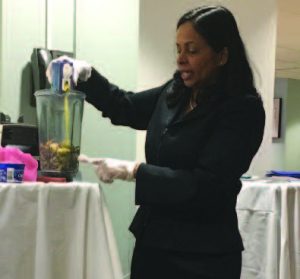 REDUCING SALT AND ENHANCING FLAVOR
REDUCING SALT AND ENHANCING FLAVOR
In honor of Black History Month, Trinitas addressed high blood pressure within the African-American community with a cooking demonstration on reducing sodium in your day-to-day diet. Michelle Ali, Director of Food & Nutrition Services at Trinitas, shared key tips on how to reduce salt without losing the flavor in your meal. Trinitas hosts programs every month open to all members of the community on a variety of topics. For a full list of upcoming events, refer to the Community Events on page 60.
 TRINITAS LISTED AMONG TOP EMPLOYERS IN THE UNITED STATES
TRINITAS LISTED AMONG TOP EMPLOYERS IN THE UNITED STATES
For the second year in a row, Becker’s Hospital Review has named Trinitas Regional Medical Center one of the 150 Top Places to Work in Healthcare. The hospital, which employs almost 2,800 individuals, developed its “Pat on the Back” awards program to recognize employees who go above and beyond on a continuous basis. Trinitas also recognizes five employees annually with the Elizabeth I. Kellogg Award which includes $5,000 for their commitment to the hospital’s mission, vision and values. Employees can take advantage of the hospital’s tuition reimbursement program, on-site fitness facility and leadership academy program; in addition, employees who use the Trinitas network are offered discounted healthcare services at Trinitas sites throughout the state.
 LITTLE RED HATS WARM HEARTS IN A BIG WAY
LITTLE RED HATS WARM HEARTS IN A BIG WAY
Trinitas participated in the American Heart Association’s Little Hats, Big Hearts program to empower new moms to live heart-healthy lives while raising awareness of congenital heart defects, the most common type of birth defect in the country. As part of the Little Hats, Big Hearts program, babies born at Trinitas in February received a red crocheted hat and a kit full of heart-healthy information for mom and baby.
 GOING RED WITH TORY BURCH
GOING RED WITH TORY BURCH
Big thanks to Bloomingdale’s at The Mall at Short Hills, who very generously donated a beautiful red Tory Burch Tote in honor of American Heart Month. Trinitas employees and community members purchased a chance to win the bag, raising awareness of Heart Month and over $1,700 to support the cardiac area of Trinitas’ emergency department expansion project. Congratulations to our winner, Trinitas employee Nancy Farrell!
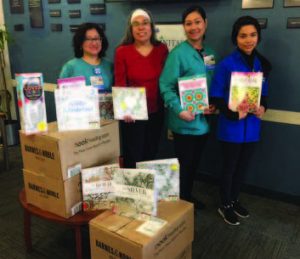 COLOR ME CALM
COLOR ME CALM
Barnes & Noble in Springfield made a special donation of four cartons filled with coloring books for the Trinitas HELP Program. These coloring books are an extension of art therapy, which has been shown to reduce stress, anxiety and increase self-esteem in adults. From left to right: Diana Noboa (Elder Life Intervention Assistant), Veronica Vargas (Barnes & Noble), Johanna Thomas (Elder Life Intervention Clinician), and Kathryn Loaiza (HELP Volunteer).
EDGE takes you inside the area’s most creative kitchens.
 Paragon Tap & Table • Crispy Skin Pan Seared Salmon
Paragon Tap & Table • Crispy Skin Pan Seared Salmon
77 Central Ave. • CLARK
(732) 931-1776 • paragonnj.com
Paragon has been ranked in the top 10 gastropubs since it opened in 2014. In addition to our elevated craft experience we also offer local and sustainable foods such as this Crispy Skin Pan Seared Salmon from Farro Island. I am always looking for new, inventive and seasonal ways to create and pair foods with uncommon balance.
— Eric B. LeVine, Chef/Partner
 Arirang Hibachi Steakhouse • Wasabi Crusted Filet Mignon
Arirang Hibachi Steakhouse • Wasabi Crusted Filet Mignon
1230 Route 22 West • MOUNTAINSIDE
(908) 518-9733 • partyonthegrill.com
We prepare a crusted 8-ounce filet mignon served with gingered spinach, shitake mushrooms, and a tempura onion ring.
 Daimatsu • Sushi Pizza
Daimatsu • Sushi Pizza
860 Mountain Ave. • MOUNTAINSIDE
(908) 233-7888 • daimatsusushibar.com
This original dish has been our signature appetizer for over 20 years. Crispy seasoned sushi rice topped with homemade spicy mayo, marinated tuna, finely chopped onion, scallion, masago caviar, and ginger. Our customers always come back wanting more.
— Chef Momo
 Publick House • Publick House Fish & Chips
Publick House • Publick House Fish & Chips
899 Mountain Ave. • MOUNTAINSIDE
(908) 233-2355 • publickhousenj.com
Our fish and chips have been a staple dish since we opened, and one our guests have come back for them time and time again. The secret lies in the delicate beer battering, coating the fish just enough to provide a crispy exterior, while not masking the flakey, delicate cod. With a large pile of our hand-cut, double-fried house fries, this is the perfect dinner any day.
— Bernie Goncalves, Owner
 The Barge • Cioppino
The Barge • Cioppino
201 Front Street • PERTH AMBOY
(732) 442-3000 • thebarge.com
Our Cioppino, the signature dish of San Francisco, features a fresh, healthy selection of clams, mussels, shrimp, Maine lobster and Jersey scallops—drizzled in Greek virgin olive oil, with fresh garlic and white wine—over homemade Italian linguini. I know it will become one of your favorite dishes.
— Alex Vosinas Chef/Owner
 Luciano’s Ristorante & Lounge • House Made Mafalda Pasta Inverno Style
Luciano’s Ristorante & Lounge • House Made Mafalda Pasta Inverno Style
1579 Main Street • RAHWAY
(732) 815-1200 • lucianosristorante.com
Our goal is to give our guests a pleasurable dining experience, with fresh ingredients and personable service in a beautiful Tuscan décor complete with fireplaces. Our house-made Mafalda pasta features slow-braised artichoke crowns, cipollini onions and oven-dried tomatoes in a saffron cream broth. Luciano’s is available for dining and private parties of all types.
— Joseph Mastrella, Executive Chef/Partner
 Morris Tap & Grill • Grilled Eggplant with Portobello
Morris Tap & Grill • Grilled Eggplant with Portobello
500 Route 10 West • RANDOLPH
(973) 891-1776 • morristapandgrill.com
In addition to our signature burger featured in the Top 50 Must-Have Burgers in the USA, we also offer vegan options such as this Grilled Eggplant with Portobello, roasted tofu and tomato basil sauce. Our 50 tap lines feature some of the top beers in the country. Keep an eye on our social media and website for upcoming events.
— Eric B LeVine, Chef/Partner
 Spirit: Social Eatery and Bar • Double Cheddar Infused Burger
Spirit: Social Eatery and Bar • Double Cheddar Infused Burger
250 Morris Ave. • SPRINGFIELD
(973) 258-1600 • mclynns.com
It doesn’t get better then a double cheddar infused burger from the new Spirit: Social Eatery and Bar.
— Mark Houlker, Chef
 Arirang Hibachi Steakhouse • Volcano Roll
Arirang Hibachi Steakhouse • Volcano Roll
23A Nelson Avenue • STATEN ISLAND, NY
(718) 966-9600 • partyonthegrill.com
Hot-out-of-the-oven, crab, avocado and cream cheese rolled up and topped with a mild spicy scallop salad.
Galloping Hill Caterers
 Galloping Hill Road and Chestnut Street • UNION
Galloping Hill Road and Chestnut Street • UNION
(908) 686-2683 • gallopinghillcaterers.com
Galloping Hill Caterers has been an incredible landmark for nearly sixty years. We pride ourselves in delivering “over the top” cuisine, impeccable service and outstanding attention to detail. That is the hallmark of our success! Simply, an unforgettable experience. Pictured here is one of our crepes flambé that really creates lots of excitement!
— George Thomas, Owner
 Vine Ripe Markets
Vine Ripe Markets
430 North Avenue East • WESTFIELD
(908) 233-2424 • vineripemarkets.com
Fresh mozzarella is not just for caprese salads and pizzas! Try to pair it with flavors and proteins that accentuate its beautiful texture and subtle flavor. I recommend our store-made fresh mozzarella wrapped with prosciutto di parma and topped with a fig demi-glaze. The saltiness of the prosciutto, paired with the subtle sweetness of the fig sauce provides for a perfect salty/sweet bite every time! Available daily in our deli.
— Frank Bruno, Chief Culinary Officer
Do you own a local restaurant and want to know how your BEST DISH could be featured in our Chef Recommends restaurant guide?
Call us at 908.994.5138
Necessity may be the mother of invention, but invention’s children are somewhat less predictable.
By Luke Sacher
One of the best movies I’ve seen in years is David O. Russell’s Joy, a biopic starring Jennifer Lawrence as Joy Mangano, inventor of the Miracle Mop, holder of over 100 patents and one of America’s top contemporary industrial entrepreneurs. “I watch somebody struggle with something,” she explains, “and it instantly triggers something in me. I start to think, ‘There is a better way. It’s going to help so many people.’ I become laser-focused on getting to that. I do not stop until I figure out the solution.”
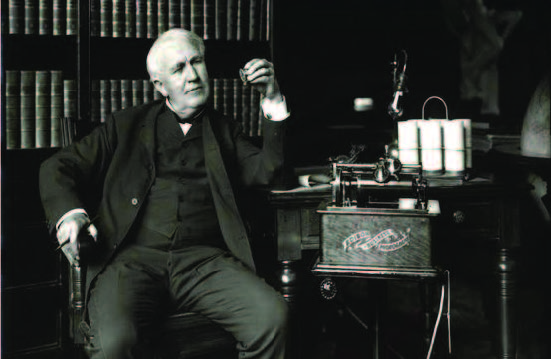
Library of Congress
Thomas Edison said almost exactly the same thing: “I never pick up an item without thinking of how I might improve it. There’s a better way, I shall find it.” Obviously, comparing the hands-free mop to Edison’s phonograph, incandescent light bulb, stock ticker or motion picture camera is a false equivalency. But let’s give the lady credit where it’s due. She and the Wizard of Menlo Park are kindred spirits, sharing personality traits common to all inventors, including imagination, initiative, persistence and a vision of a future where the human experience is more efficient and enjoyable.
Edison (above) also famously noted that genius is “one percent inspiration and 99 percent perspiration.” And he was correct. Invention can be a sweaty, dirty and sometimes dangerous business, especially when short-term results are the driving motivator. If you think about it, this is the basic plot of every Roadrunner cartoon. Plus, invention is full of economic uncertainty, for it involves pushing knowledge forward into places where little or no knowledge exists. “We do not know what it is that we do not know,” economist Israel Kirzner once observed. Additionally, we do not know the true cost of finding out what it is that we do not know—or whether it is even worthwhile knowing. “That is where entrepreneurship comes in,” Kirzner concluded.
In other words, not only do inventors have to get the idea and execution right to gain traction, there must also be a sound business plan behind it, too. This is why the scientists, technologists and innovators who do succeed deserve our undying admiration.
That is, until their inventions start killing us.
Alas, history is littered with big ideas that turned out to be perfectly horrible in the long run. Their costs can be measured in human lives. Fortunately, there are many more small flashes of inspiration that blossomed into true game-changers. When confronted with the products and technologies that promise to change our lives for the better today, I find it helpful to take a look back at the good and the bad.
CAN DO

National Gallery of Art
War, claimed the Greek philosopher Heraclitus, is the “father of all things.” We have war to thank for the tin can. In 1797, Napoleon Bonaparte (right) conscripted virtually every able man in France into the first modern mass army and launched it across Europe. A mob of more than one million undisciplined illiterate sans culottes, deployed from the English Channel to Switzerland, rolled over French opponents by sheer force of numbers. But an army marches on its stomach, and the Grande Armée spent more time foraging for food than fighting. On the eve of the first major battle against the Austrians, while consuming a “pot luck” dinner made from whatever his chef could scrounge up in the surrounding village, Napoleon decreed a massive prize to anyone who could devise a way to preserve and package rations for his troops. In 1810, after 15 years of experiment, Nicholas Appert claimed that prize—on the condition that he make his invention public. That year, he published The Art of Preserving Animal and Vegetable Substances. Appert lived in Epernay, the home of champagne. He modified the heavy bottles as storage containers by shortening the necks to widen the opening. He then filled them with various foods, placed them in boiling water for 30 minutes, and sealed them with corks and wire cages. Ironically, he had also accidentally invented pasteurization—30 years before Louis Pasteur made the scientific connection between heat and killing bacteria!

Science Museum of London
Meanwhile, across the Channel, a pair of Englishmen, Bryan Donkin (right) and John Hall, acquired the patent for a lighter, unbreakable container, the tin-plated steel can. In 1813, they built the world’s first commercial canning factory in London, and produced their first tin-canned goods exclusively for the Royal Army and Navy. Soon all the other European Empires adopted the tin can to provision the ranks of their own armies and navies. But there was just one fly in the ointment, so to speak. This advance in food preservation and portability was not without its setbacks. Early tin cans were crudely sealed with a 50/50 tin and lead alloy solder. Troops in the field and sailors on the high seas would customarily reheat their contents while still in the cans, exposing the lead alloy to acid and dissolving the lead in the food. It’s disconcerting to think that all of the soldiers and sailors in the armies and navies of Europe might have been half-crazy from lead poisoning during the mid-1800s. It might be part of the reason why the Crimean War (1853–1856) is well remembered for its “great confusion of purpose”

Upper Case Editorial
and “notoriously incompetent international butchery.”
Fortunately for the civilian population, canned foods were not mass-produced until the final decades of the 19th century. That happened after William Lyman invented the can opener in 1870, and the crude technique of soldering cans shut with globs of lead had been discontinued. Today, 40 billion cans of food are consumed in just Europe and the United States, according to the Can Manufacturers Institute. The tin can revolutionized how, what and when people could eat—not at all a small contribution to the growth and health of the global population.
THE COLOR PURPLE
Mauveine. Never heard of it? Think “mauve” and settle in for a roller-coaster ride through a century of innovation. It begins around 1800 with James Watt, whose improvements to the steam engine in the 1780s triggered the Industrial Revolution. William Murdoch, a research assistant at Watt’s steam engine works in Birmingham, England, realized that coal could be used for something other than engine boiler fuel: Heat coal up in a kiln and it emits flammable gases that could be collected, stored, and used as fuel for illumination. Eureka…gas light was invented. Within a few years, complete gaslight piping networks were built in London and other major cities in Great Britain.
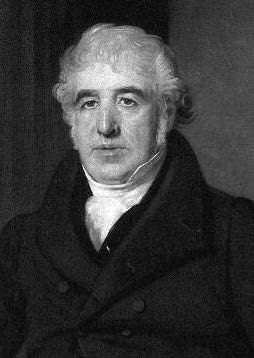
Engraving by Edward Burton
What remains of the coal after the gases are cooked out of it? Coal tar. Sticky muck, reeking of ammonia. What to do with it? It was the Industrial Revolution, remember, so the short answer was throw it into the rivers. Enter a man from Glasgow named Charles Macintosh (left), a clothing and dye maker who needed the ammonia as a solvent and bleach. After a bit of fiddling, he managed to extract another solvent from the tar, naphtha, which turned out to be the perfect solvent thinner for a newly imported material from the Orient: rubber. He sandwiched the thinned rubber between two layers of fabric and in 1824 invented a game-changing raincoat, the Mackintosh!
People interested in chemistry began asking themselves what else might be extracted from coal tar. The British, who were facing a malaria crisis in their Far Eastern colonies, hoped that the only remedy for the mosquito-borne disease, quinine, might somehow be synthesized from coal tar. In 1856, a young British chemist named William Perkin (above right) tried for months without any luck to coax quinine from coal tar. One day, he tossed another of his failed solutions
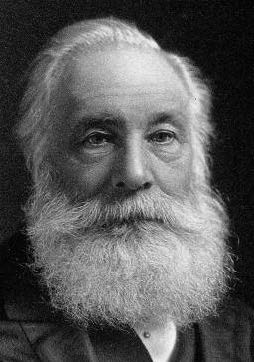
A History of Chemistry
into the sink, where it mixed with water and turned bright Royal Mauve. By complete accident, he had stumbled upon the world’s first artificial aniline dye, which he named Mauveine. This “invention” made him a fortune thanks to the emerging middle class of the industrial age, who were keen to emulate Queen Victoria’s sartorial splendor. Ironically, Perkin’s luck appeared to run out when he attempted to persuade British academia and the investor class of the potential for progress and profits to be realized by creating a full industrial chemical industry. They were happy to keep building railroads and textile mills. So he approached academics and investors in Germany, where intellectual merit counted for more than family ancestry. By 1870, German chemical corporations like Agfa, BASF, Hoechst, and Bayer had left the rest of Europe in their wake, inventing everything from dyes to aspirin to artificial fertilizer to high explosives. All derived in one way or another utilizing coal tar.
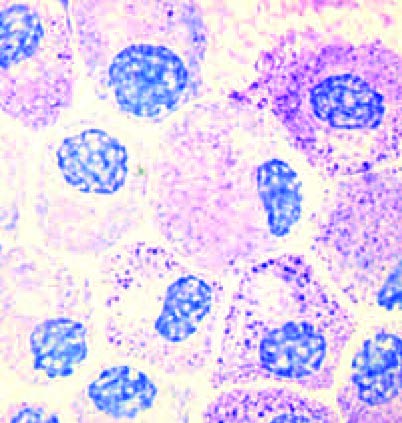
Upper Case Editorial
In 1882, German pathologist Paul Ehrlich accidentally spilled some mauveine dye into a petri dish only to notice that it selectively stained only one kind of bacteria. Ehrlich continued his research and, 17 years later, invented Salvarsan, the first chemical treatment for syphilis. Ehrlich became the father of a new science, which he named Chemotherapy. In 1908, he won the Nobel Prize for Medicine.
THAT CERTAIN GLOW
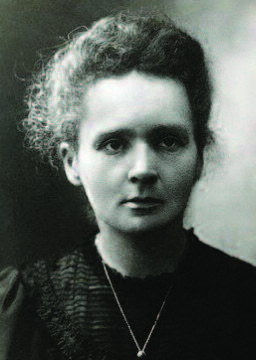
Upper Case Editorial
In 1898, Marie (left) and Pierre Curie discovered radium. In 1903, they were both awarded the Nobel Prize in Physics. Marie was the first woman ever to win the prize. Eight years later, she received a second Nobel, for isolating radium, discovering a second atomic
element, polonium (named after her home nation of Poland), and her groundbreaking research into “radioactivity” (a word she invented). By then, radium was being industrially refined and Marie Curie was convinced that it had potentially “magic” healing properties. Indeed, for many years, she wore a pendant around her neck containing pure radium.

Upper Case Editorial
Madame Curie was not alone. Burk & Braun’s Radium Schokolade chocolate bar and Hippman-Blach bakery’s Radium Bread, both made with “radium enriched” water, were very popular and profitable. They were both discontinued in 1936. The Revigator stored a gallon of water inside a bucket with an enamel lining impregnated with radium. Its manufacturers claimed that drinking Revigator water could cure arthritis and reduce skin wrinkles. Toothpaste containing both radium and thorium (radium’s “grandfather” element) was sold by Dr. Alfred Curie. He was no relation to Marie or Pierre, but seized upon the opportunity to capitalize on their common name. Alfred Curie also manufactured Tho-Radia cosmetics, a line that ecompassed powders, creams and lipsticks that promised to rejuvenate and brighten ladies’ faces.
Early 20th century physicians produced radium suppositories, heating pads, and coins used to “fortify” single glasses of water. They were meant to treat rheumatism, weakness, malaise, and almost any health complaint for which their hypochondriac patients sought miracle cures. Before Viagra and Cialis, impotence was treated with radioactive “bougies” (the French word for candles)—wax rods inserted into the urethra—and athletic supporters containing a layer of radium-impregnated fabric. A popular treatment called the Radioendocrinator involved a small “portefeuille” holding a number of paper cards coated in Radium, worn inside underwear at night. Its inventor died of bladder cancer in 1949.
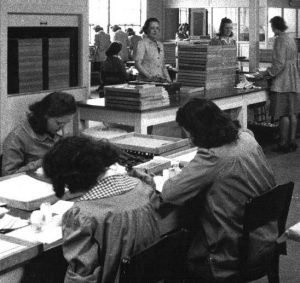
Soapbox Productions
Perhaps the most famous misuse of radium occurred between 1917 and 1936, when the U.S. Radium Corporation employed more than a hundred workers—mostly young women (below) just out of high school—to paint watch and clock faces with their patented “Undark” paint. As many as 70 women were hired to mix the paint, which was formulated of glue, water, and radium sulfide powder. Workers were taught to shape paint brushes with their mouths to maintain a fine point, and after work hours, painted their nails and teeth with the glow-in-the-dark paint for personal amusement. The company encouraged the young women to ingest the dangerous mixture, while its management and research scientists (who were aware of the danger) carefully avoided any exposure themselves. Five “Radium Girls” sued the U.S. Radium Corporation and won a large settlement in a landmark case involving labor safety standards and workers’ rights. There are no verifiable records of exactly how many suffered from anemia, inexplicable bone fractures, bleeding gums, and necrosis. Though many of the factory’s workers became ill, cases of death by radiation sickness were initially attributed to diphtheria, and even syphilis, in an attempt to smear their reputations.
CHEMICAL ATTRACTION

National Academy of Sciences
Every so often, a brilliant solution to one problem will create an even larger one. An inventor hailed as a hero during his or her time ends up being recast as a villain by history. Meet Thomas Midgley, Jr. (right), inventor of leaded gasoline and Freon. If you didn’t know he was a real person, you’d think he was a character from Kurt Vonnegut’s Cat’s Cradle. Over the course of his career, Midgley was granted over 100 patents, including those for tetraethyl leaded gasoline (commonly called TEL and trademarked as Ethyl), and the first chloroflurocarbons (commonly called CFCs and trademarked as Freon).
Midgley began working at General Motors in 1916. In 1921, he discovered that the addition of tetraethyl lead to gasoline prevented engine “knocking.” GM named the substance Ethyl, and made no mention of lead in its reports and advertising. Oil companies and auto makers, especially GM,

Upper Case Editorial
which owned the patent jointly with Midgley, promoted the additive as a superior alternative to ethanol, on which there was very little profit to be made. In 1923, the American Chemical Society awarded Midgley the Nichols Medal for the Use of Anti-Knock Compounds in Motor Fuels. He then took a prolonged vacation in Miami to cure himself of lead poisoning.
Later in the decade, Midgely was assigned to another GM division, Frigidaire. The modern, self-contained plug-in refrigerator had existed for almost two decades by then, but it used refrigerant chemicals that were not only toxic and corrosive, but occasionally explosive, including ammonia, chloromethane, propane, and sulfur dioxide. Midgely was tasked with finding a safer alternative. His research team incorporated fluorine into a hydro-carbon and synthesized dichlorodifluoromethane, the first chlorofluorocarbon (CFC). They named it Freon. Freon soon became the standard refrigerant, and was later used in aerosol spray cans and asthma inhalers (!) as a propellant. In 1937, The Society of Chemical Industry awarded Midgley the Perkin Medal (named after Henry Perkin, aka Mr. Mauveine) for his invention.

Upper Case Editorial
Though recognized as a brilliant chemist, Midgely can claim two of history’s most environmentally catastrophic inventions. The release of large quantities of lead into the atmosphere has been linked to long-term health problems, including neurological impairment in children and increased levels of violence and criminality in major population centers. The ozone-depleting and greenhouse gas effects of CFCs only became widely known 30 years after Midgely’s death. Author and scholar Bill Bryson summed Midgley up beautifully when he remarked that he possessed “an instinct for the regrettable that was almost uncanny.” Environmental historian J.R. McNeill said that Midgley “had more impact on the atmosphere than any other single organism in Earth’s history.”
BRIGHT, SHINY OBJECTS
Say what you will about the law of unintended consequences, but it is most definitely an equal-opportunity destroyer. But a good invention gone bad doesn’t always harm people. Sometimes it only demolishes an industry. In 1981, the compact disc hit record stores, the very thing it would inadvertently kill. The 5” CD replaced LP records and audio cassettes. Its size rendered music packaging unimportant, ending an era of album-cover art that brought some of the world’s most gifted artists and photographers into our homes. The quantum leap in audio quality CDs delivered—which did not erode over time as vinyl and magnetic tape did—fulfilled the promise of the early digital age.
For the next 20-or-so years, the CD was one of the best things that ever happened to the record industry. Baby Boomers, grown older and wealthier (and less interested in new music), were all too happy to re-purchase their favorite albums, even at double the price of the old LPs. Industry revenues soared. Record company executives, keen on generating foolproof profits, were delighted to sell their existing catalogs in a new package. At the same time, they also poured big money into recording contracts with established superstars and the overnight sensations created by that other thing that began in 1981, MTV. A lot of that cash came out of the budgets traditionally earmarked for promising acts that needed more career nurturing. They were put on starvation diets and pressured to produce hit videos instead of developing loyal audiences. The result was a mix of aging, bloated artists and one-hit wonders.

Photo by Santeri Vinamaki
I was a part of the industry during this period, having contributed to over 100 music videos as an assistant cameraman and camera operator from 1983 to 1995. I worked with Van Halen, Joe Jackson, Guns ’n Roses, Anita Baker, The Beastie Boys, Kenny G, Jazzy Jeff and The Fresh Prince, James Taylor, Willie Nelson and dozens more. Most of the shoots were great fun, 20-hour days notwithstanding. The few that were pure misery were mostly caused by despicable talent managers, producers and “A&R men” who would squeeze every last bit of production value out of both crewmembers and stage or location expenses. I was almost seriously injured (and possibly killed) more than a few times. On the continuous spectrum of business ethics, you can find promoters and managers of pop music artists somewhere south of people who look after the best interests of professional boxers.
Industry executives had been warned by their engineers since Day One that digitizing music in the form of a CD would, one day, mean a loss of control of their content. Although they had been reaping profits from digital technology for nearly two decades, they were still analog thinkers. The chickens came home to roost in 1999, when personal computers like the iMac, with plug-and-play capability, arrived. The new generation of desktops and laptops were configured with built-in Internet and drives that not only could play CDs but also “rip” them as MP3 files. The industry had reduced its product to digital data, and now anyone with a computer could take it for free. Even a novice user could become an audio engineer after a few days of online tutorial, ushering in an era of anonymous, shame-free theft through file-sharing sites like Napster
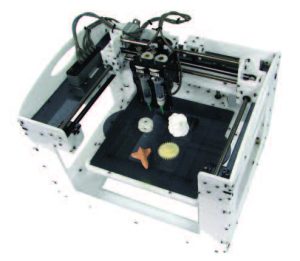 Music piracy, a minimal concern until then, cratered the industry. In the ensuing years, more than 370,000 jobs were eliminated. Music companies and artists lose more than$50 billion annually. A generation ago, bands toured to promote album sales, which climbed into the hundreds of thousands or even the millions. Today, they hit the road to survive, and for all but a fortunate few, music sales barely pay the catering bill.
Music piracy, a minimal concern until then, cratered the industry. In the ensuing years, more than 370,000 jobs were eliminated. Music companies and artists lose more than$50 billion annually. A generation ago, bands toured to promote album sales, which climbed into the hundreds of thousands or even the millions. Today, they hit the road to survive, and for all but a fortunate few, music sales barely pay the catering bill.
SHIFT F7…BANG!
If you could make almost anything—and I mean anything—from a chess piece to a heart valve to a gun, all by yourself, in your garage…what would you make? Today’s most intriguing wait-and-see invention has to be the 3D printer. Known as additive manufacturing (AM), this technology creates three-dimensional objects by successive layering of material under computer control. 3D printers use an Additive Manufacturing file (AMF) created with a 3D scanner, or a camera with special “photogrammetry” software, or a computer assisted design (CAD) package. The machine itself uses a number of different production technologies, which frankly are so beyond my personal knowledge that I can’t even begin to describe them: Binder Jetting, Directed Energy Deposition, Material Extrusion, Material Jetting, Powder Bed Fusion, Sheet Lamination and Vat Photopolymerization.
3D printers support almost 200 different materials in four basic categories: plastic, powder, resins, and “other.” Other can include titanium, stainless steel, bronze, brass, silver, gold, ceramics, chocolate, glass, concrete, sandstone and gypsum. Printers capable of producing household chemicals, pharmaceutical medications, and even living tissue cultures for transplant organs are currently in an experimental stage. Their developers envisage both industrial and domestic use for this technology, which would also enable people in remote locations to be able to produce their own medicine or replacement parts for other machines
Just as nobody could have predicted the profound cultural impact of the printing press in 1450, the steam engine in 1750, or the transistor in 1950, it is impossible to predict the impact of 3D printing. However, 3D printing makes it possible to produce single items for the same unit cost as producing thousands, thus undermining a foundational law of mass production: economy of scale. It will almost certainly have as profound an effect on the world as the advent of the production line and the factory did more than a century ago. Futurist Jeremy Rifkin has claimed that 3D printing marks the beginning of a third industrial revolution.
What will that revolution look like? By the end of the decade, you will be able to create many of the things that now require a special trip to a store on an affordable home 3D printer. Just download the file, push print. Sounds like fun, right? Well, consider the fact that in 2012 a Texas company posted design files for a fully functional plastic gun that could be produced by anyone with a 3D printer

Modern Readers
The U.S. Department of State made the company take down the file after several months, but if you learned anything from the CD story in this article, you know the genie was long out of the bottle by then
According to a memo released by Homeland Security and the Joint Regional Intelligence Center, “significant advances in 3D printing capabilities, availability of free digital 3D printable files for firearms components, and difficulty regulating file sharing may present public safety risks from unqualified gun seekers who obtain or manufacture 3D printed guns…[and] proposed legislation to ban 3D printing of weapons may deter, but cannot completely prevent their production. Even if the practice is prohibited by new legislation, online distribution of these 3D printable files will be as difficult to control as any other illegally traded music, movie or software files.”
The memo overlooks a key problem with 3D firearms. You could murder someone and then pop your gun into the microwave, melting any evidence of the crime. Who knows? Maybe the unintended consequence of 3D printing will be an entirely new branch of forensics. This could get interesting
EDITOR’S NOTE: Luke Sacher has another connection to this story. He served as cinematographer for the 1987 film Radium City, and met many of the “Radium Girls.” In her New York Times review, Janet Maslin wrote: “The film is about the desire for independence that led those teen-age girls to the plants in the first place, about facing up to hardship and about the dangers of being too well-bred to ask questions—it is a story too important to be ignored.”
Is it time for a retirement reboot?
By Christine Gibbs
The dictionary is very precise in defining retirement: Withdrawal from one’s position or occupation or from active working. For a growing number of people in New Jersey and around the country, that definition barely hints at the reality of retirement. A generation ago, half of all Americans said they expected to retire comfortably by age 65. By contrast, according to a recent survey, about 25% of Americans now anticipate that retirement won’t begin until age 70 or later. According to AARP, 40% of Baby Boomers nearing retirement expect to “work until they drop.” So much for Webster’s.

www.istockphoto.com
The math is far from encouraging. According to the U.S. Census Bureau, 13% of the current U.S. population is over 65, with projections escalating to 18% in 2030 and doubling in 2050 to almost 90 million. This puts stress not only on retirees, but also on their entitlements. Given that the average length of retirement is 18 years, right now four out of five Americans aged 30 to 54 say they are convinced they will not have sufficient funds to comfortably retire, and expect little help from diminished Social Security benefits when the time comes. They may be right. The Boston College Center for Retirement Research estimates that, as a nation, we are a mind-boggling $6.6 trillion short of what Americans will need to retire comfortably.
If you’ve fully funded your retirement and feel confident that you can maintain a high standard of living and achieve all of your post-career dreams, you can stop reading here. If not, let’s do a reality check.
WHAT RETIREMENT LOOKS LIKE
The first meaningful step toward retirement is visualizing what life will look like for you. It won’t be the same as it is today, especially if you are behind in building your nest egg. You will almost certainly downsize in terms of your living situation. If you own a home, try to put a conservative number on what kind of cash a sale will generate when you move to something smaller or less expensive. And then think about what it will cost to live in your next home—taxes, utility bills, maintenance. Maybe you’ll be renting. Or sharing a home with your children.

www.istockphoto.com
How do you envision your lifestyle? Will you be taking around-the-world cruises or more modest travel adventures? Will you be joining country clubs or giving up your existing memberships? Will you be a buyer or a seller when it comes to the finer things in life, such as art, antiques or collectibles? Will you be eating out a lot or eating in?
Remember, everything comes with a price tag including, unfortunately, your health. Health issues increase with age, which often involve unexpected escalating medical obligations. Psychological and emotional distress often increases as we grow older. In fact for many, chronic anxiety and depression begin pre-retirement as we face the realities of aging. Although Medicare and private insurance plans can cover most of these costs, any decline in health—even a temporary one—is likely to erode your finances. Plan realistically for this eventuality. You don’t want to be 80 and snapping pills in half so you can afford to keep the lights on.

www.istockphoto.com
TIME AND MONEY
So where to start? A good place to begin your retirement reboot is by determining how much you will really need to save in order to make your late-in-life fantasy come true. Any good game plan must start with an honest personal assessment. The two critical factors to consider are when and how do you hope to retire. There are a plethora of online calculators that let you plug in financial and other data to calculate how much cash to stash to achieve defined goals. There are an equally vast number of retirement experts and advisers out there offering professional assistance.

www.istockphoto.com
Financial planners like to recommend saving 10 to 15 percent of your annual income starting as early as your 20s. A recent USA Today article suggests saving $300 per month starting at age 25 and investing aggressively (not to mention successfully) will accumulate more than $932,000 by age 65. Delaying saving by a decade would reduce the total nest egg to $408,000, while increasing the monthly savings by $100 would increase it to about $1.2 million. Which makes me wonder: Do any 25-year-olds read USA Today? Are you 25? The answer to both questions is probably not.
If you are in your 40’s or 50’s and have yet to pull your head out of the sand when it comes to saving for retirement, fear not. All is not lost. In fact, there is a consensus among the “big boys” in the financial arena on how to get back on track even when the retirement clock is ticking. A good place to start is to estimate how much cash you will need in your retirement kitty based on your projected monthly expenses.
DID YOU KNOW?
- The ancient Greeks would stockpile valuable olive oil as a way to survive during difficult times, including old age.
- Revolutionary War patriot Thomas Paine proposed a controversial public pension system in a pamphlet published in 1795.
Monthly Income Need Savings Needed for 20 Years Savings Needed for 30 Years
$1,000 $166,696 $212,150
$2,000 $333,392 $424,300
$3,000 $500,087 $636,450
$4,000 $666,783 $848,601
$5,000 $833,479 $1,060,751
$6,000 $1,000,175 $1,272,901
$7,000 $1,166,871 $1,485,051
$8,000 $1,333,567 $1,697,201
$9,000 $1,500,262 $1,909,351
$10,000 $1,666,958 $2,121,501
The above sums assume your portfolio will earn a 6 percent annualized return during the course of your retirement and endure 2 percent annual inflation erosion.
Obviously, the first step is to start growing your savings faster than you’re growing gray hairs. Clark Howard, a successful consumer expert, in one of his books entitled Living Large for the Long Haul, extends his own personal lifeline to those who have passed the 40-year mark with no savings for retirement.
- Crunch Retirement Numbers Realistically
- Income (salary, portfolio, social security, pension)?
- Unsettled debt?
- Expenses?
- Get Aggressive
- Stop stalling and start saving—as much as you can, as soon as you can!
- Play catch-up: If you are 50 or older, the IRS lets you make extra contributions to supplement your retirement savings accounts.
- Rethink Your Retirement Timetable
- Keep working beyond the standard retirement age.
- Supplement with part-time work.
- Scale back
- Get real about expenses and luxuries.
DID YOU KNOW?
Medicare was signed into law by President Lyndon Johnson in 1965. It established eligibility at age 65.

www.istockphoto.com
THE FINAL FRONTIER
What will the world look like for retirees now in their 40’s or 50’s? They will be part of what one strategic forecasting agency recently referred to as “a tsunami of senior citizens.” It may change the very nature and culture of the United States, and will certainly have a major impact on the economy. By their sheer numbers, seniors will represent a juggernaut voting block, and millions of new jobs and perhaps even new industries will be devoted to their needs. And remember, this is based on current life-expectancy rates. With advances in medicine, a lot of today’s 50 year-olds will reach triple-digits. They are only halfway home!
DID YOU KNOW?
88% of Americans today are worried about retirement as compared to 73% in 2010.
DID YOU KNOW?
The U.S. Census Bureau indicates that average savings for a 50 year-old today is $42,797.
What do those next 50 years have in store for us? A Place for Mom, a very successful for-profit senior living referral service, recently put forth the following predictions:
- A drastic decline in traditional nursing homes in favor of continuing care communities and aging-in-place with at-home care.
- Improved technology to include a wide array of accurate health-monitoring wearables, smart homes powered by cloud-based artificial intelligence, and even exo-suits worn under or over clothing to enhance mobility.
- Neighborhood-friendly civic planning to accommodate common senior limitations.
- Going green among the graying population through eco-friendly domestic design to save energy and money while making seniors safer.
- A booming healthcare industry based on the Bureau of Labor forecasting job growth at 70% for home health and personal care aides.
In the end (no pun intended) a happy, healthful, meaningful retirement comes down to quality of life. And in that regard, everyone is different. For some, it’s a matter of money—of never having to say no to something because you can’t afford it. For others, it’s about staying engaged and maintaining a positive outlook—of never being afraid to say yes. Just as everyone is different, every retirement is different, too. The more you can picture your own bright future, the more realistic your chances are of making it happen.
DID YOU KNOW?
Age 66 is the full eligibility age for Social Security for anyone born in 1954 or earlier, with partial benefits available starting at age 62. For those born after 1954, the eligibility age increases by two months per birth year until it reaches 67.
We welcome the community to our programs that are designed to educate and inform. Programs are subject to change.
SEMINARS
Seminars, unless otherwise noted, will be held at the CORE Building, 1164 Elizabeth Ave., Elizabeth, NJ
(Enter parking lot from South Broad St., next to Fire House) Register online or call (908) 994-8939.
WEDNESDAY, APRIL 19 • 5:30 pm
The Truth Behind Immunizations
Clark Sherer, MD, Chief of Infectious Diseases, Director of Medical Students Education
Register at www.TrinitasRMC.org/Immunizations
WEDNESDAY, APRIL 26 • 5:30 pm
Parenting Children with Autism: Strategies for Success from a Multidisciplinary Team
Carole Soricelli, MS, OTR
Director of Trinitas Children’s Therapy Services Trinitas Children’s Therapy Services
899 Mountain Avenue, Suite 1A, Springfield, NJ 07081
Register at www.TrinitasRMC.org/AutismAwareness
THURSDAY, MAY 11 • 5:30 pm
Go Red for Women’s Event
Mirette Habib, MD, Interventional Cardiologist
Register at www.TrinitasRMC.org/GoRed
WEDNESDAY, MAY 17 • 5:30 pm
Stroke: Who is at Risk?
Terry Finamore, MS, BSN, RN, Coordinator for Stroke and Bloodless Medicine & Surgery Programs
Register at www.TrinitasRMC.org/StrokeAwareness
WEDNESDAY, MAY 24 • 5:30 pm
What Does Your Skin Say About You?
Carol Blecher, RN, MS, AOCN, APNC, Nurse Practitioner
Register at www.TrinitasRMC.org/SkinCancerDetection
THURSDAY, JUNE 8 • 5:30 pm
How Safe is Your Home?
Diana Youssef and Krystle Rodriguez, Neighborhood Revitalization Coordinators, Habitat of Humanity
Register at www.TrinitasRMC.org/HomeSafety
THURSDAY, JUNE 15 • 5:30 pm
Alzheimer’s Diseases: Life after Diagnosis
Tim Clyne, BA, MSN, RN, CDP, Nurse Manager, HELP Program; Diane Reehil, MSN, GNP, CNN, Clinical Nurse Specialist, HELP Program; Johanna Thomas, BA, CDP, Elder Life Intervention Clinician, HELP Program
Register at www.TrinitasRMC.org/AlzheimersAwareness
TCCC SUPPORT GROUPS
Conference Room A or Conference Room B
Trinitas Comprehensive Cancer Center
225 Williamson Street, Elizabeth New Jersey 07207
All events take place from 1pm to 3pm.
Call (908) 994-8535 for 2017 schedule.
Living with Cancer
Viviendo con Cáncer, Grupo De Apoyo
Living with Breast Cancer
Viviendo con Cáncer de Mama
Caregiving Support Group
Viviendo con Cáncer, Grupo De Apoyo
Viviendo con Cáncer, Apoyo Familiar
For more information on any TCCC support programs and to RSVP, please contact Roxanne Ruiz-Adams, LSW, (908) 994-8535. Por favor llame al (908) 994-8535 para confirmar su asistencia.
TRINITAS HEALTH FOUNDATION EVENTS
THURSDAY, MAY 4
6:00 pm
Annual Gala Dinner Dance
The Venetian, Garfield, NJ
Join the foundation as they honor Connie Dwyer at this beautiful black tie event complete with fantastic live music, dancing, an incredible auction and amazing food and drink.
For more information about the Foundation or to learn more about its fundraising events, (908) 994-8249 or nbrechner@trinitas.org.
Proceeds from these and other events benefit the patients of Trinitas Regional Medical Center. Making reservations for Foundation events is fast and easy on your American Express, MasterCard, Visa or Discover card!
SPECIAL PROGRAMS
Health Services with Women In Mind
Trinitas helps provide women access to vital health services with a focus on preventive measures. These include educational programs and cancer screenings. Programs offered in English and Spanish.
To learn more about these services, contact Amparo Aguirre, (908) 994-8244 or at amaguirre@trinitas.org
Ask the Pharmacist: Medication Management
Free of charge, by appointment only.
Monthly on the 4th Tuesday, 11:30 am – 1:00 pm
Call (908) 994-5237
MEDICAL AND BEHAVIORAL HEALTH SUPPORT GROUPS
Diabetes Management Support Group
Monthly, First Monday, 2:00 – 3:00 pm
Kathleen McCarthy, RN, CDE (Certified Diabetes Educator)
Open to both diabetics and non-diabetics who want to learn more about diabetes prevention.
65 Jefferson Street, 2nd Floor, Elizabeth, New Jersey Call (908) 994-5502 for further information or registration
Sleep Disorders
If you or someone you know experiences problems sleeping, consider contacting the Trinitas Comprehensive Sleep Disorders Center in Elizabeth. Another location can be found in Cranford at Homewood Suites by Hilton with easy access on and off the Garden State Parkway. Both centers are headed by a medical director who is board certified in sleep medicine, internal medicine, pulmonary medicine, and intensive care medicine, and is staffed by seven certified sleep technologists.
For further information, call (908) 994-8694 to learn more about the Trinitas Comprehensive Sleep Disorders Center or visit www.njsleepdisorderscenter.org
Narcotics Anonymous
Monday 7:00 – 8:30 pm
Sunday 12:00 noon – 2:00 pm; Sunday 5:00 – 6:30 pm
Jean Grady, Community Liaison, (908) 994-7438 Grassmann Hall, 655 East Jersey St., Elizabeth
Alcoholics Anonymous
Friday 7:30 pm – 8:45 pm
Jean Grady, Community Liaison, (908) 994-7438 Grassmann Hall, 655 East Jersey St., Elizabeth
HIV Education and Support Program for HIV Positive Patients
Monthly. Call for scheduled dates/times.
Judy Lacinak, (908) 994-7605
Early Intervention Program Clinic, 655 Livingston St. Monastery Building, 2nd Floor, Elizabeth
Mental Illness Support Group (NAMI) for Spanish Speaking Participants
4th Friday of each month except August, 6:30 pm – 8:30 pm Mike Guglielmino, (908) 994-7275
Martha Silva, NAMI 1-888-803-3413
6 South Conference Room, Williamson Street Campus 225 Williamson Street, Elizabeth
TRINITAS CHILDREN’S THERAPY SERVICES
899 Mountain Avenue, Suite 1A, Springfield, NJ • (973) 218-6394
“10 Tips…” Workshops
Come take part in the 7th year of our highly successful Ten Tips Workshop Series. The series is for parents, teachers, or other individuals who work with young children and focus on practical strategies that can be easily implemented into daily classroom and/or home routines. All of our workshops offer suggestions that are appropriate for all children with an emphasis placed on children with special needs and those who may be on the Autism Spectrum.
All workshops take place at the Trinitas Children’s Therapy Services Center, 899 Mountain Ave, Suite 1A, Springfield NJ. Workshops are $15 each.
April 18, 2017 6:00 pm – 7:30 pm
10 Tips for Building Fine Motor Skills
During Circle Time Activities
May 16, 2017 6:00 pm – 7:30 pm
10 Tips for Building Sensory/Tactile Processing
During Large Group Activities Time Activities
June 13, 2017 6:00 pm – 7:30 pm
10 Tips for Building Gross Motor Skills into Large Group Activities
For more information or to register for this last workshops, please contact Christine German, OTD, OTR, at (973) 218-6394, ext. 4012, or email CGerman@trinitas.org
Winter/Spring Programs:
February 20-May 22
All programs are offered one time per week, for 45 minutes at Trinitas Children’s Therapy Services,
899 Mountain Avenue, Suite 1A, Springfield, NJ 07081
These programs and/or group therapy sessions are a great alternative to individual therapy. They give children the opportunity to address key developmental areas
in structured but busier environments that are more reflective of typical real-life home and school situations. Classes are grouped by skill and age level.
Scribbles to Script
Children from preschool (prewriting) through elementary school (cursive) have the opportunity to use the Handwrit-ing Without Tears program to learn pre-writing skills, proper letter formation, and writing within the given lines. Multi-sensory fine motor, visual-motor, and visual-percep-tual activities help to reinforce learning and make writing fun! 45-minute classes held once weekly.
Sports 1 Step at a Time
Children between the ages of 4 & 12 will have the opportunity to work with a PT to refine their skill set for several sports, including soccer, basketball, and kickball, in a non-competitive group setting. 45-minute sessions held once weekly. Mondays 4:15 – 5:00
Social Butterflies
Children between the ages of 4 & 12 have the opportunity to become social butterflies by engaging in fun non-challenging therapeutic activities overseen by a speech & language pathologist. Skills taught include turn taking, topic maintenance, appropriate question asking, following non-verbal cues, and using manners. 45-minute sessions held once weekly. Wednesdays 4:15- 5:00
Typing Whizkids
Children from 1st grade through middle school will partici-pate in functional tasks that will allow them to learn efficient keyboarding/typing skills. From key location and finger placement, to speed and accuracy children will learn this v a l u a b l e s k il l t h e c o r r e c t w a y w h i l e w o r k i n g with an OT. 45-minute sessions held once weekly. Thursdays 6:15 – 7:00
Cook With Us
An opportunity for children to work with a PT and certified personal trainer, to learn the basics of daily nutrition and fitness, and simple meal and snack preparation, in a practical and fun environment. 45-minute sessions held once weekly. Wednesdays 4:30 – 5:15
Parents Night Out
Please inquire about our quarterly “Parents Night Out” event. Drop your child(ren) off for a few hours of fun play time, a movie and a snack, while mom and dad enjoy a much needed night out. Takes place quarterly.
April 7th 6:00 – 8:30
June 9th 6:00 – 8:30
7th Annual Camp Trinitas
Now accepting registrations for Summer 2017
The program is the perfect opportunity to have children gain new skills or maintain recently-learned motor and academic skills without a full day or even full week commit-ment. Sign up for as many days or weeks as you would like. Sign up for a ½ day or a full day.
We will now be located off-site, with a classroom, an outdoor space, a playground, a kitchen, and a larger gym area! We will now be offering the option of either a ½ day or a full day!Allow your child to participate in a camp directly organized and supervised by skilled clinicians in their respective fields. Camp Trinitas is run by OT’s, PT’s, speech therapists, and ABA clinicians, to address each child’s specific needs.
Early Bird Special: 1ST 10 Camp Registrants receive a 10% discount.
Whole Camp Experience Special: Sign up for all 7 weeks and all 28 days and receive an additional 10% discount.
To register for any programs or for more information, please contact Kevin Nelson at knelson@trinitas.org,(973) 218-6394, ext. 13, or fax (973) 218-6351.
To learn more, visit www.childtherapynj.com
This page is sponsored by
Elizabethtown Healthcare Foundation
Inspired to Care, Inspired to Give
WE’RE ALMOST THERE!
 If you have visited us lately, you know that big things are happening at Trinitas! We are in the home stretch of an $18.7 million state-of-the-art expansion and renovation of our Emergency Department, which will decrease wait times and increase patient safety, comfort and satisfaction. This expansion—which will also create special areas for children, seniors and behavioral health patients—will be completed in August 2017.
If you have visited us lately, you know that big things are happening at Trinitas! We are in the home stretch of an $18.7 million state-of-the-art expansion and renovation of our Emergency Department, which will decrease wait times and increase patient safety, comfort and satisfaction. This expansion—which will also create special areas for children, seniors and behavioral health patients—will be completed in August 2017.
We have raised almost $16 million to date. We are very proud to say that Trinitas board members, physicians, leadership and staff have come together and donated over $2.5 million to this important project, showing their commitment to providing the highest level of care to all the patients we serve.
Would you like to be a part of all the excitement? To find out how you can help the patients of Trinitas and have your gift matched dollar-for-dollar by the JC Kellogg Foundation, please call Nadine Brechner or Rob Eccles at the Trinitas Health Foundation at (908) 994-8249.
TRINITAS IN THE WINNERS CIRCLE
 On February 25, 2017 hundreds of Trinitas supporters joined us at the Meadowlands Racetrack for Trinitas Health Foundation’s 13th Annual Evening at the Races. Attendees enjoyed a great night of action for an important cause, by joining us in the Winners Circle to benefit the patients of Trinitas Regional Medical Center! For information about attending or sponsoring upcoming events please call Joanne McGann at (908) 994-8249. Pictured above, Gary S. Horan, FACHE, President & CEO of Trinitas RMC (center), took in the race with wife Arlene Horan (left) and Chris & Karen Horan.
On February 25, 2017 hundreds of Trinitas supporters joined us at the Meadowlands Racetrack for Trinitas Health Foundation’s 13th Annual Evening at the Races. Attendees enjoyed a great night of action for an important cause, by joining us in the Winners Circle to benefit the patients of Trinitas Regional Medical Center! For information about attending or sponsoring upcoming events please call Joanne McGann at (908) 994-8249. Pictured above, Gary S. Horan, FACHE, President & CEO of Trinitas RMC (center), took in the race with wife Arlene Horan (left) and Chris & Karen Horan.
SNYDER FOUNDATION LEAVES LASTING IMPRESSION
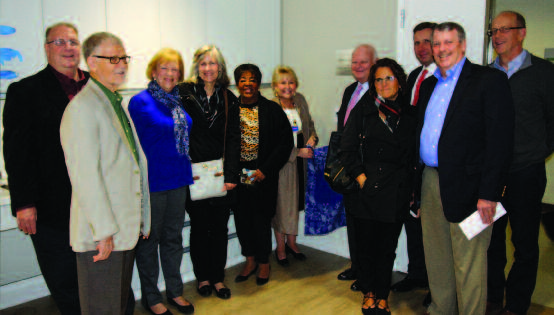 Representatives from the Harold B. and Dorothy A. Snyder Foundation (left) visited Trinitas Regional Medical Center to get a firsthand look at the Emergency Department’s (ED) amazing transformation. Top on their list was a tour of the ED’s new Diagnostic Imaging Unit, since their generous grant helped pay for the unit’s technologically advanced 128 Slice CT Scan. This state-of-the-art equipment allows physicians to diagnose and treat patients far more quickly than ever before. The trustees pictured left stand proudly by their plaque in the Diagnostic Unit, which commemorates their beloved trustee Phyllis Snyder and honors the Snyder Foundation for their generous contribution.
Representatives from the Harold B. and Dorothy A. Snyder Foundation (left) visited Trinitas Regional Medical Center to get a firsthand look at the Emergency Department’s (ED) amazing transformation. Top on their list was a tour of the ED’s new Diagnostic Imaging Unit, since their generous grant helped pay for the unit’s technologically advanced 128 Slice CT Scan. This state-of-the-art equipment allows physicians to diagnose and treat patients far more quickly than ever before. The trustees pictured left stand proudly by their plaque in the Diagnostic Unit, which commemorates their beloved trustee Phyllis Snyder and honors the Snyder Foundation for their generous contribution.
New Jersey’s Arboreal Splender
Photography by Dwight Hiscano

Black River, Morris County

Redbud, Reeves-Reed Arboretum

Cedar Swamp, Pinelands

Twilight, Great Swamp

Black River/October, Morris County

White Oak in Snow

Photography by Nancy Hiscano
Internationally published and highly collected, Dwight Hiscano has been creating photographs of the American landscape for over thirty years. His prints are held in notable collections both in the U.S. and abroad, and have been presented to governors, members of Congress, and community leaders in recognition for their service. His work has been featured in numerous group and solo exhibits including the Nature’s Best exhibit at the Smithsonian, the National Geographic-sponsored International Mountain Summit in Italy, the Capitol Rotunda, and an exhibit at the Richard M. Ross Art Museum, alongside works by Winslow Homer, Thomas Hart Benton and John Marin.
Dwight’s images have appeared in The New York Times, Outdoor Photographer, Nature’s Best, Nature Conservancy Magazine and Photographic Magazine, and he was a finalist in the International Black and White Spider Awards. His photographs have been featured prominently in books, posters, calendars, websites, and annual reports in the U.S., Europe and Asia. He often leads photography workshops, lectures and gallery talks, and was the keynote speaker at the Garden Club of America’s Annual Horticultural Conference.
Dwight recently opened Dwight Hiscano Gallery in Morristown, offering his large, limited-edition prints for private collections as well as large scale installations in corporate and medical facilities throughout the Northeast.
For more information please visit www.dwighthiscano.com, contact the gallery at 908-577-2275, or email dwighthiscano@gmail.com.
News, views and insights on maintaining a healthy edge.
 Crunch Time
Crunch Time
Do loud eaters make you crazy? Then you may be suffering from Misophonia. A small percentage of people experience a strong fight-or-flight response when they hear lip-smacking, chip-crunching or liquid-gulping sounds. A recent study published in Current Biology looked at 42 individuals—20 of whom were misophonic and 22 of whom were not—who listened to noises ranging from neutral to annoying while they were in an MRI machine. Researchers observed that the 20 misophonics had significant activity in the insular cortex, which links senses and emotions. In most cases, the result was a strong feeling of anger as opposed to disgust, which is how most people respond to eating noises. Fortunately, misophonia is fairly rare, according to Dr. Rodger Goddard, Chief Psychologist at Trinitas. “It’s a problem that usually occurs between the ages of 9 and 13 and is more common in girls, and is believed to involve brain functions and not one’s ears,” he says. There is a Misophonia Foundation, which can provide guidance for people suffering from this difficulty.

Rodger Goddard, PhD
Chief Psychologist, Trinitas Regional Medical Center Director of Wellness Management Services
908.994.7334
Dr. Goddard adds that getting upset, stressed, anxious or annoyed at a variety of things is common for many of us. We need to always look at the frequency, duration and intensity of any problem. If we have an emotional difficulty that occurs on a regular basis, lasts for a significant amount of time when it occurs, or is intense in its effect on us, then it is probably time to take action and seek professional help from a doctor or therapist.
 Into the Woods
Into the Woods
Have you planned your annual spring camping adventure yet? If not, perhaps you should. A study conducted at the University of Colorado in Boulder suggests that a weekend in the great outdoors can reset the body clock—a boon to those of us who have trouble waking up in the morning or shaking the wintertime blues. More time spent outside in bright light, and less time exposed to artificial light at night, improved alertness, mood and even strength in a group of volunteers who went on weeklong camping expeditions. The results were almost as good for campers who spent just two days in the great outdoors.

Rodger Goddard, PhD
Chief Psychologist, Trinitas Regional Medical Center Director of Wellness Management Services
908.994.7334
This type of activity can be a great boost to one’s health, confirms Dr. Rodger Goddard, Chief Psychologist for Trinitas. “Paradoxically, there is a psychiatric disorder called SAD, or Seasonal Affective Disorder,” he adds. “Some people, when sunlight is decreased or restricted, become depressed.” Indeed, light—particularly sunlight—plays an important role in our health. In addition to increased exposure to sunlight, the silence, oxygen, social connection and vacation from the technology overload can do wonders for mental health.
 Cervical Cancer’s “Racial Divide”
Cervical Cancer’s “Racial Divide”
Since reaching an all-time high in 1991, the number of cancer deaths in the U.S. has come down steadily and is now 25 percent lower than it was a quarter-century ago. That includes cervical cancer deaths, which are now largely preventable with proper screening and regular monitoring. Yet, according to a study by the Bloomberg School of Public Health at Johns Hopkins, the death rate from cervical cancer is higher than previously estimated. Much of the disparity is attributable to high rates among African-American women, who are as likely to die from the disease as someone in a developing country. Their mortality rate from cervical cancer is more than double that of white women. The study did not get into the reason for this disparity, but an article in Gynecologic Oncology suggested that the relationship between income and access is the likely cause.
 But Is It An Organ?
But Is It An Organ?
Gray’s Anatomy (the book, not the TV series) lists 78 organs in the human body. Is there a 79th? According to scientists at the University of Limerick in Ireland, the tissue that connects the intestines to the abdominal wall—known as the mesentery—should be considered an organ because it performs a specific body function. Namely, the tissue works as one entity to prevent the intestines from jigging around. Which means you couldn’t survive without it. There is an actual “advantage” to being classified as an organ. It means that medical researchers are likely to pay much more attention to it. In the case of the mesentery, that could translate into progress in the understanding and treatment of abdominal disorders such as Crohn’s disease.
 Real-Time Concussion Detector
Real-Time Concussion Detector
With football increasingly in the crosshairs of the medical community, it was only a matter of time before equipment measuring concussions in real-time started finding its way onto the field. A new “smart” mouthguard should be available to players nationwide by 2018. The device, manufactured by Prevent Biometrics, calculates a player’s risk of concussion after a hard hit. That information is sent instantly to coaches, team doctors and parents, who can pull a player out of the game if need be. This is a critical decision—study after study has shown that players who stay on the field after a concussive hit take twice as long to recover compared to those who leave immediately. The mouthguard was developed with the help of the famed Cleveland Clinic.

Kevin Lukenda, DO Chairman, Family Medicine Department 908.925.9309
Dr. Kevin Lukenda of Linden Family Medical Associates thinks a computerized Bluetooth mouthguard could be a valuable tool to objectively gauge whether a player is injured and to what degree he may be concussed. “Right now, we depend on referees, coaches, parents, teachers, school physicians and even the student athletes themselves in the diagnosis of concussions,” Dr. Lukenda points out. “Many times these voices go unheard because of the consequence of limiting the student athlete’s ability to play—despite jeopardizing their health. Though there are objective measures to determine a concussion, often times the decision becomes very subjective.”
 Early Detection for Autism
Early Detection for Autism
Roughly one in every 100 babies born in the U.S. ends up diagnosed on the autism spectrum between the ages of two and four. According to a study published earlier this year in Nature, brain scans can now detect the origins of autism in the first year of life. Researchers at the University of North Carolina did brain scans on a group of children at high risk of autism (their older siblings were autistic) at 6, 12 and 24 months. The scans showed early differences in the cerebral cortex—which is responsible for high-level functions— in the children who went on to be diagnosed with autism. The study should lead to new tests for autism and, hopefully, opportunities for early behavioral therapies. It also provides a compelling argument against claims that autism is caused by the MMR (measles-mumps-rubella) vaccine, which is typically given after 12 months of age. “The idea that autism is caused by vaccination has been disproved,” conforms Lucille Esralew,

Lucile Esralew, PhD, NADD-CC, CDP
Clinical Administrator for Trinitas CARES and S-COPE
908.966.3033
PhD, NADD-CC, CDP, the Clinical Administrator for Trinitas’s CARES and S-COPE outreach programs. “There is no credible scientific evidence that link the two.” Until such time as brain scans are widely available, pediatricians can detect signs of autism using the Modified Checklist for Autism in Toddlers-Revised (MCHAT-R) as early as 18 months, while psychologists use the Autism Diagnostic Observation Schedule—the gold standard for assessment with children beginning as young as age three. “The Autism Diagnostic Inventory (ADI-R), a comprehensive review of a child’s early social, communication, behavioral and adaptive skills history is also utilized in assessment.” April, adds Dr. Ersalew, has been designated as Autism Awareness Month.
The Connie Dwyer Breast Center comes to Trinitas.
By Mark Stewart
Connie Dwyer knows how lucky she is. Lucky to have lived through the ordeal of breast cancer, to be sure. And lucky to have had the emotional and financial support she needed to make it through a double-mastectomy, reconstructive surgery and chemotherapy after being diagnosed in 1999. But it was during her chemo sessions, Dwyer recalls, that she came to understand just how lucky she was.
“I underwent treatment in a room with several other people,” she says. “There was one young woman in particular who took a bus to get there, and then had to take two more buses to get to her job, where she was an hourly worker. She had two children at home that she had to provide for. Chemotherapy is such a shock to your system, physically and mentally. I often think back to the courage she demonstrated, and about how traumatic it would have been for me without the support of my husband, Bob, and our three wonderful daughters. I know it sounds like a cliché, but I wanted to give back.”

Above: A detailed floor plan for the new Conniee Dwyer Breat Senter, which willl be unveiled the Fall.
And so she did.
In 2004, the Dwyers began working to raise funds for St. Michael’s Medical Center in Newark. They saw a specific need—uninsured women without access to critical services—that was being addressed by the hospital, and created a fund that eventually grew into many millions of dollars
In 2016, St. Michael’s was purchased by Prime Healthcare, a for-profit medical corporation. Legally, their charitable organization could no longer be affiliated with the hospital, so the Dwyers created the Connie Dwyer Breast Cancer Foundation and began looking for a new home
Long story short: later this year, Trinitas will open the $3 million Connie Dwyer Breast Center
“We spoke to a number of places that would have loved to have had us come,” says Dwyer, “but at our very first meeting with Trinitas we were so taken with Nadine Brechner, Gary Horan and all the doctors we met—they were all ‘from-the-heart’ kind of people. You could tell how much they cared about their patients and the women in the surrounding communities. It was an immediate connection. Bob and I felt very comfortable with them, and our board agreed that Trinitas was the best place for us to go.”
Janet Lesko, who has worked with Dwyer since 2004, now serves as the Director of the Connie Dwyer Breast Cancer Foundation. Lesko confirms that they “fell in love” with the people at Trinitas, and adds that Dwyer herself remains the organization’s driving force
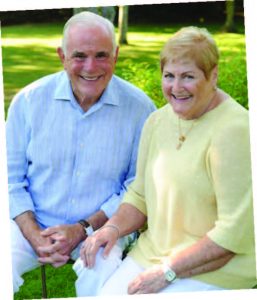
Photo by L.A. Brown
“Connie’s vision, leadership and dedication has enabled us to help so many women receive breast cancer screening, diagnosis, and treatment in our community,” she says. “We are delighted to now have the opportunity to expand our reach through a partnership with Trinitas Regional Medical Center.”
“Thanks to Connie’s empathy, sensitivity and generosity, the patients of our region will have a state-of-the-art facility designed for best possible outcomes and compassionate care,” says Nadine Brechner, Executive Director of the Trinitas Health Foundation. “We are most thankful for her partnership.”
“Our missions are actually a perfect match,” points out Trinitas President and CEO Gary Horan, FACHE. “We provide excellent, compassionate healthcare to all the people we serve, including those among us who are poor and vulnerable. We appreciate Connie’s confidence and trust in Trinitas to help further the loving mission of her foundation
As for Dwyer’s newly-independent organization, she says it is laser-focused on its mission to provide breast care and education to uninsured women. The experience has also provided another, unexpected, benefit: Many of her 12 grandchildren have gotten involved.
“By helping me with this work,” she says, “it has made an important impression on them. They have a real sense of what you can do for others in life.”
EDITOR’S NOTE: Connie Dwyer is being honored at the Trinitas Health Foundation Annual Gala on May 4, 2017 at The Venetian in Garfield, NJ. For tickets or sponsorship information, please call (908) 994-8249 or e-mail nbrechner@trinitas.org. For more information on the Connie Dwyer Breast Cancer Foundation, log onto cdbcf.org.
High-tech mannequins keep Trinitas nursing students on the cutting edge.
By Diane Alter
Remember the Mannequin Challenge, the viral phenomenon that swept the nation in 2016?Well, that was nothing new to the Trinitas School of Nursing (TSON). Mannequins have been teaching and challenging TSON students since 2005, when the first high-fidelity patient simulator arrived. It was called SimMan and it was developed by Laerdal Medical Corporation. Since then the nursing school’s population of high-fidelity patient simulators has steadily grown. The school’s faculty has become increasingly adept at using these medical mannequins to demonstrate key aspects of safe patient care and teach students how to respond to emergency situations.
TSON’s Learning/Simulation Center is currently equipped with 23 high, medium and low-tech patient simulators.
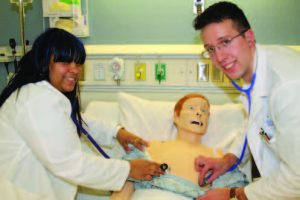 Seven are high-fidelity computer-operated mannequins that have heartbeats, can breathe, talk, sweat and simulate a wide range of medical conditions and responses to treatment. Two are birthing simulators that can simulate the birth of a baby and the complications of pregnancy and childbirth. Also featured in the lab are part-task simulation trainers. These are smaller simulation pieces of equipment that mimic specific parts of the human body. They are used to practice delicate procedures, such as intravenous therapy, urinary catheterization and colostomy care.
Seven are high-fidelity computer-operated mannequins that have heartbeats, can breathe, talk, sweat and simulate a wide range of medical conditions and responses to treatment. Two are birthing simulators that can simulate the birth of a baby and the complications of pregnancy and childbirth. Also featured in the lab are part-task simulation trainers. These are smaller simulation pieces of equipment that mimic specific parts of the human body. They are used to practice delicate procedures, such as intravenous therapy, urinary catheterization and colostomy care.
“The benefits of using the mannequins for teaching are many,” Donna Penn, Dean of the Trinitas School of Nursing, says. “The students practice skills and techniques. They also learn how to communicate, problem-solve, and engage in critical thinking—all in a very safe and controlled environment. The mannequins provide an interactive environment that permits hands-on experience where students can make mistakes and learn and grow from them.”
Assistant Deans Monina Franco-Tantuico and Rose Santee explain that the mannequins also allow students to reflect and think back on what they did right or wrong, and change their behavior as needed. The devices also allow teachers to create scenarios that students will hopefully never see, but if and when they do, they will have received training on how to react.
“It is a very effective and modern way to teach,” says Franco-Tantuico.
“It makes all of us think more, and it keeps us all on our toes,” adds Santee.
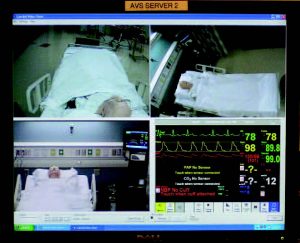 The Learning/Simulation Center also includes a digital audio-visual system that transmits and records situations in a simulated environment to facilitate learning. Control rooms for the simulation area permit instructors and computer specialists to remotely operate the mannequins. An adjacent debriefing room enables instructors and students to review the video recording of the simulated scenario and engage in a reflective discussion of what occurred during that simulation. The Learning/Simulation Center is just one more example of how TSON continues to enhance students’ learning environment and promote professional growth.
The Learning/Simulation Center also includes a digital audio-visual system that transmits and records situations in a simulated environment to facilitate learning. Control rooms for the simulation area permit instructors and computer specialists to remotely operate the mannequins. An adjacent debriefing room enables instructors and students to review the video recording of the simulated scenario and engage in a reflective discussion of what occurred during that simulation. The Learning/Simulation Center is just one more example of how TSON continues to enhance students’ learning environment and promote professional growth.
The school’s commitment to excellence is continually recognized and rewarded. TSON was yet again designated as a National League for Nursing Center of Excellence (COE) for 2015-2020 in the category of “Creating Environments that Enhance Student Learning and Professional Development.” This marks the third consecutive COE designation in this category since 2008.
Editor’s Note: The TSON’s Learning/Simulation Center has been filmed by The National League for Nursing, the premier organization for nurse faculty and leaders in nursing education.
Trinitas launches a new telehealth initiative.
By Ghilianie Soto
In the healthcare business, it’s all about follow-up. Heading into 2017, Trinitas established Project ECHO to build on the successes of Crisis Assessment Response and Enhanced Services (CARES) and Statewide Clinical Outreach Program for the Elderly (S-COPE)—two of its most innovative outreach initiatives. CARES, a statewide funded program by the NJ Division of Mental Health and Addiction Services, is a crisis response team for community dwelling adults with intellectual and developmental disabilities and co-occurring mental health and behavioral disorders. S-COPE provides a similar service to older adults in long-term care. The monitoring, coaching and regional training offered by the CARES and S-COPE teams were strictly on-site.
Project ECHO extends these vital offerings via the Internet.
Project ECHO—which stands for Extension for Community Healthcare Outcomes—uses virtual conferencing via a platform called Zoom to hold sessions with guests and partners, including group homes, day programs, hospitals, nursing homes, and clinicians who manage cases for CARES and S-SCOPE. Partners can participate via smartphone, laptop, desktop or tablet. Family members of an individual diagnosed with behavioral health issues can also submit cases for review by Project ECHO experts
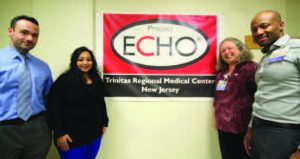
A few of the members of “the Hub” at Trinitas’ New Point Campus. From left to right: Phillip Caruso, LPC (Clinical Supervisor, CARES), Mobin Chadha, LCSW (Clinical Coordinator, S-COPE), Lucille Esralew Ph.D., NADD-CC, CDP (Clinical Administrator, CARES & S-COPE) and Bonny Uchenna Life, MA,MPP (Program Coordinator, CARES).
“Our motto is ‘Move the right knowledge to the right place and to the right people,’” says Lucille Esralew, Ph.D., Clinical Administrator of CARES and S-COPE, who oversees Project ECHO. “Instead of transporting individuals with complex needs long distances to specialists, we can now provide specialty consultation at the primary point of care. Partners can essentially conference in from the comfort of their own homes if they so choose.”
The aim of Project ECHO is to equip providers, families, and clinicians with best-practice approaches to serve individuals with complex problems. Where extreme solutions are often offered by an agency or provider that could potentially be more detrimental to the overall mental health of a client, Project ECHO provides a space to fully review the case and offer alternative solutions with the client’s best interest. Project ECHO also serves as a tool to train community providers, facility providers as well as students in social work, nursing, psychiatry, professional counseling and psychology.
Each Project ECHO session includes two case presentations and a brief exercise or didactic on a related topic. All client information is kept confidential. The sessions last approximately 1.5 hours and consist of an inter-professional team known as “The Hub.” The Hub of the Project ECHO team includes psychologists, advanced practice nurses (APNs), social workers, behaviorists and professional counselors. The client never appears during the session, nor are the sessions intended to be a method for delivering treatment. The intent is to increase the number of professionals involved in providing care and services to a particular client
Project ECHO was originally developed in 2003 by Sanjeev Arora, MD, and his team at the University of New Mexico. The program was initially designed to train and mentor local providers in rural New Mexico in the care of HIV patients due to the scarcity of specialists and the difficulty in accessing specialty care. Dr. Esralew—along with several Trinitas staff members including Leone Murphy, APN (S-COPE), Bonny Uchenna Life (CARES), Phil Caruso LPC (CARES), and Mobin Chadha (LCSW)—attended a five-day training session in Albuquerque in late 2015.
Project ECHO sessions are held twice a month for S-COPE and CARES, and are broadcast out of Trinitas’ New Point Campus in Elizabeth. Another specialty project involving developmental disabilities and dementia was recently added. This program is funded by an HRSA Geriatric Workforce Enhancement Project, through which Trinitas partners with Rowan University School of Osteopathic Medicine.
Although Project ECHO’s telehealth format is used worldwide, current applications and resources for behavioral health with vulnerable adults remain limited in New Jersey. While some parts of the state are heavily populated—with competent psychiatrists and behavioral health experts—other areas are in real need of critical guidance.
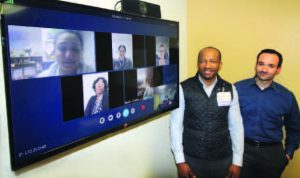
Bonny Uchenna Life, MA, MPP (left), and Phillip Caruso, LPC, launch an ECHO session with the rest of “the Hub” team conferencing in via Zoom.
“There will never be enough specialists, but we can train and incentivize those who do exist,” explains Dr. Esralew. “There has to be a mechanism that matches the needs of each client with a provider in order to make changes to the system of care for these individuals.”
With over 1,000 cases seen by CARES in the state of New Jersey in 2016, Project ECHO is poised to make a profound difference in a lot of lives in 2017.
For more information on Project ECHO contact:
 Mobin Chadha, LCSW
Mobin Chadha, LCSW
Clinical Coordinator, S-COPE mchadha@trinitas.org
For more information on CARES call 1-888-393-3007. For information on S-COPE call 1-855-718-2699.
What happened to the domestic robot revolution?
By Mark Stewart
A decade ago, Bill Gates made a bold prediction to readers of Scientific American. The visionary billionaire heralded the coming of a revolution in domestic robotics, writing that they could have “just as profound an impact on the way we work, communicate, learn and entertain ourselves” as the PC. Some time in the relatively near future, he believed, the typical American household would feature robots that clean the home, prepare food, do the laundry, dispense medicine, mow the lawn, provide security and drive the family car.
Fast-forward to 2017. The future of robotic “home helpers” is moving at a Roomba-like pace.

iRobot
Ah, Roomba. Admit it, back when the autonomous vacuum cleaner debuted in the early 2000s, you envisioned a not-too-distant future populated by droids that relieved your family of the dreaded Three D’s: dull, dirty and dangerous. You know, the stuff you’re already willing to pay someone else to do. Americans did buy something like 10 million Roombas and, over the years, new models became smarter and more reliable. But honestly, is this where we thought we’d be at this point?
The main obstacle to the long-promised domestic robot revolution has been money. The developers who should be creating game-changing household helpers have been focusing their talents on industrial and military applications. Why? Because that’s who’s paying good money for the technology. These are customers that have calculated a return on investment and given robot manufacturers lucrative contracts that guarantee a high degree of economic certainty.

20th Century Fox
How much would you pay to have a gleaming, capable, intelligent, articulate C3PO shuffle into your life? What would your neighbor pay? What would your mom or dad pay? This is the problem; no one can really answer these questions yet. Right now, the job of creating a truly functional I Robot-style household helper is too big, too complicated and too expensive. Churning these units out in sufficient numbers to make them affordable would seem unfeasible for decades to come. For that to happen, robots would have to get a lot more effective when it comes to relating to humans, and someone would have to make a huge investment to accelerate this process.
ENTER ELON
Neither point, it turns out, is a deal-killer. Futurists and technology experts agree that performing mundane household chores happens to be a great proving ground for the next generation of robots, not just domestic ones. For example, an ironing robot recently developed at
Columbia University had to overcome two obstacles: understand how much pressure to apply to a garment and recognize wrinkles. Both tasks relied on extremely advanced scanning and sensing technologies—the kind that would absolutely have to be a part of any household robot. These technologies, in turn, would be needed in the development of robots that would one day replace highly skilled, highly paid workers who do exhausting or dangerous jobs. So the incentive is there to chase after the domestic market as a sort of stepping stone to bigger and better things.
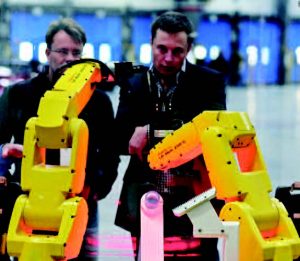
Steve Jevetson
These types of advances ultimately rely on the great leaps in artificial intelligence (AI). For visionaries like Elon Musk (above), those leaps can’t come soon enough. The man behind Tesla, SpaceX and other high-profile ventures is now devoting his considerable resources to accelerating artificial intelligence in ways that will push the robot revolution forward. He is one of several tech giants bankrolling a non-profit company called OpenAI (openai.com), which has established the near-term goal of making a domestic robot.
According to the company’s web site, OpenAI is “working to enable a physical robot (off-the-shelf; not manufactured by OpenAI) to perform basic housework. There are existing techniques for specific tasks, but we believe that learning algorithms can eventually be made reliable enough to create a general-purpose robot. More generally, robotics is a good test bed for many challenges in AI.” Musk sees robots as instruments of positive change that will benefit humanity rather than harm it. This, he believes, can be accomplished by freely collaborating with other institutions and developers, and making its patents and its research open to the public
So, you ask, when will my Roomba masseuse be ready to lay its robotic hands on me?
Not so fast. Giving robots the level of AI required to administer a deep-tissue massage is not something we should do without considering the possible consequences. Stephen Hawking, for one, believes that bestowing the ability to learn on machines will lead to the ability to re-design themselves. That ability, he maintains, poses an existential threat to humanity, because this will happen at an ever-increasing rate until robots decide that humans are an unnecessary annoyance. Imagine a worldwide web of domestic robots that suddenly decide we’re not worth keeping alive anymore. Musk and his co-investors happen to share this apocalyptic vision of robots gone wrong. They believe that the openness of OpenAI is the best safeguard at this point
ON THE MARKET
What’s out there now? The fact is, a typical household could conceivably own a half-dozen or more robots right now. The Roomba is one of a number of devices that do things as well (or almost as well) as an unskilled human. In this EDGE issue, in fact, we feature two in our gift pages: a robot gutter cleaner and a robot kitty litter cleaner. The advantages of the litter cleaner should be obvious to anyone with a cat. It senses when a feline is finished and scoops its waste into a drawer in the base with a carbon filter to cut down on the odor. It’s a robot in a very basic sense, in that it relieves humans of sifting and scooping. The gutter cleaner is a more specialized item that still requires its owner to climb a ladder in order to turn it loose. It then buzzes along, dislodging and ejecting leaves and debris. Anyone who owns these items almost instantly realizes what the truly ”robotic” versions might one day do: deposit the cat waste
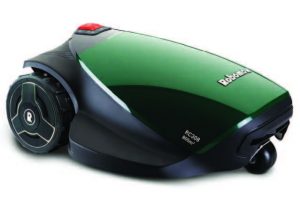
RoboMow
in the garbage, and levitate in and out of gutters without the use of a ladder. The AI involved in these advances is formidable, to say the least.
Right now the household robots that enjoy the most success tend to be outside-the-home devices, such as robotic pool cleaners and lawn mowers. Pool-cleaning robots work like relentless miniature tanks, crawling along the pool bottom and sides, power-washing and suctioning. Solar-powered robotic pool skimmers have also become popular. The same companies that produced “automatic” pool cleaners have all added AI to their units, jumping on the robotic bandwagon.
Several companies now make robotic lawnmowers. They operate cordlessly, much as a Roomba would. Most models run automatically, on a schedule the owner determines. There is an advantage here because two or three “touch-ups” instead of a big cut allows the trimmings to work their way back into the soil instead of turning brown under the sun. The mowers require an invisible dog fence-like wire to be installed around the perimeter of your property, but after that it’s pretty much a set-it/forget-it operation. If they miss a few spots (which they almost invariably do) a few whacks with a string trimmer and you’re done. A good robo-mower will run you upwards of $1,000 and possibly upwards of $2,000. That’s the one-season cost for a good lawn service, so these machines do pay for themselves.
INSIDE JOB
For most people, the first foray into household robotics tends to be an exterior product—a pool cleaner or lawnmower, for example. Is it because we want robots to “prove themselves” on the other side of a thick wall before we invite them into our homes? Certainly, the issue of human trust is a key component of the domestic robot revolution, and at the moment we don’t really trust them enough to invite them into a more intimate relationship. That may change soon, because AI is all around us—monitoring our likes and dislikes, anticipating our interests and desires, and creating a comfort level that will serve as a gateway to human-robot partnerships inside our kitchens, bathrooms, and wherever else we want to save time and avoid drudgery.
What are the folks behind the domestic robot revolution doing to get us to that point?
First and foremost, they are focused on interaction. Domestic robots need an interface that is both engaging and comfortable. Some important groundwork has been laid by Apple with Siri and Amazon with Echo, its intelligent personal assistant. As much as humans like to think that we are “teaching” these technologies to work with us, we really are the ones being taught. The other piece of the interaction puzzle is the development of AI with which we don’t have to interact. The more household devices learn about who we are, what we’d like them to do—and how and when we’d like them to do it—the better. No one enjoys having to remind a spouse or housemate to do something over and over again. We’ll be even less enthusiastic if we have to tell a machine the same thing more than once or twice. We’ll want our domestic robots to be subservient and respectful of our precious time.
In terms of a domestic robot’s appearance, the jury seems to be out. Do we want to share our living space with a humanoid machine? Those who say yes are probably looking for an element of companionship in a robot. Which is absolutely okay. Those who say no recognize that a domestic robot in a human package would likely encounter a number of physical obstacles and be a lot more expensive that something more utilitarian. One that looks more like an “appliance” and less like a person will be just fine. I believe that household robots are more likely to take the form of beloved droids in popular culture—maybe Rosie

www.istockphoto.com
on The Jetsons or R2D2 from Star Wars or Sonny in the aforementioned I Robot
If and when we do develop the technology to give our robots human bodies—both inside and out—it strikes me that they would quickly become a lot more than mere domestic workers. Think about it. They would look and sound like humans. They would be smarter, kinder and more intuitive than people, too. If they cook, clean, shop, drive and do home repairs well, doesn’t that make them domestic partners? If my wife found someone who could do and be all those things, she’d leave me at the nearest jughandle. I pity the fellows who’ll have to compete with robot suitors a couple of generations from now.
There is a final consideration where humanoid domestic robots are concerned.
Should we actually get to the point where our robotic helpers do look and function like Sonny, why would we keep them cooped up in the house? We’d want to show them off, right? In fact, assuming they were intelligent enough and mobile enough, wouldn’t we expect them to function as our surrogates, doing all the boring stuff we don’t want to do? Perhaps even our jobs?

You can see why futurists believe there is a slippery slope to fully autonomous androids. At some point, household robots would just find us to be a nuisance. And instead of us hitting the power-down button on them, they might be pulling the plug on us
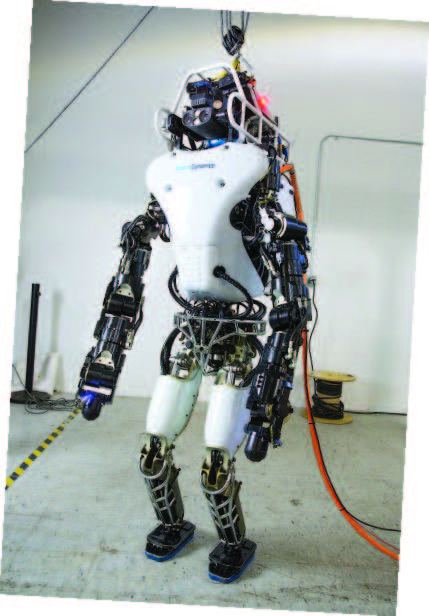
US Deparment of Defense
UNTETHERED
Not surprisingly, the good people at the U.S. Department of Defense are keeping an eye on the domestic robot revolution. As a matter of fact, they have also gotten in on the fun. In 2015, the Defense Department held a Robot Challenge with a $2 million first prize. Twenty-three companies entered the competition, which required an “untethered” robot to complete eight tasks that mimicked activities of the first responders to the Fukushima nuclear disaster. A Korean robot won. It was one of only two to complete all eight tasks, including walking across rubble, climbing steps, opening a door and driving a car.
The future of eating well is right under our feet.
By Yolanda Navarra
Everyone used to say my grandmother should have opened a restaurant.
Instead, she married a man with an eight-acre apple orchard and evergreen farm in Holmdel, where he also grew organic vegetables, fruits and flowers. The farm was a magical place and their marriage—farmer and chef—made their house a farm-to-table paradise for me. Whenever she called, I’d squint my little eyes and hold my breath, hoping, for a dinner invitation, which was usually a creative feast of whatever she’d collected from the farm that morning. The first time I ever tasted a Jerusalem artichoke, I was an 11-year-old who couldn’t get enough of unusual flavors. I lived for them. I’ve never forgotten the smell of spices in the kitchen or picking apples from trees, and looking out at the land wondering what might be ready to harvest. All these years later, the flavor of that first Jerusalem artichoke is still on the tip of my tongue.
A New Jersey upbringing doesn’t make me a foodie any more than being hungry for just-picked produce makes me a farmer. Yet with the thousands of farms—and farmers markets and farm-to-table restaurants—dotting the Garden State, I am hardly alone in my obsession for eating local.

Courtesy of Rachel Weston
The state’s official website celebrates the fact that New Jersey continues to live up to its nickname. Our farmers are producing quality crops. While food and agriculture is our third largest industry, New Jersey ranks highest in the production of cranberries, spinach, bell peppers, blueberries and peaches. We also raise famously delicious Jersey tomatoes, corn, apples, strawberries, potatoes, hay, soybeans and nursery stock. Jersey Fresh, a 33-year-old program sponsored by the New Jersey Department of Agriculture to educate consumers about the state’s crops, reports that our farmers grow more than 100 varieties of produce and hundreds of thousands of dollars worth of specialty crops. As of 2015, we have 9,100 farms spread out over 715,000 acres of land that generated $1.02 billion in sales the previous year
Rachel J. Weston, chef and author of New Jersey Fresh: Four Seasons from Farm to Table, (the subject of a 2015 EDGE story), says, “If you haven’t eaten corn harvested that same morning, strawberries still warm from the sun or tomatoes just brought in from the field; you haven’t experienced the bounty of the Garden State…[and] when farmers and chefs collaborate together on showcasing Jersey Fresh products in a meal the results are memorable.”
Weston recommends preserving summer and fall produce for winter by making jars of jams, pickles, chutneys, salsas and tomatoes that will be ready to go even if the ground is frozen. In fact, her freezer is stocked with local berries, peaches, pesto and eggplant. Winter finds her cooking with storage crops, including potatoes, carrots and winter squash. She also can’t resist shopping at farmers markets for various mushroom varieties, which are grown in climate-controlled greenhouses
“I supplement a bit from the grocery store,” she concedes, “but with some planning and creativity, it is possible to eat well year-round.”
But it’s not only about the food; Weston also enjoys the personal connection. “Shopping directly from farmers and through a season-long C.S.A. (Community Supported Agriculture, aka “farm share”) program or a visit to a roadside stand provides the opportunity to meet the people who grow our food, learn how it is grown and the opportunity to have fresher, more flavorful options, while supporting our local economy.
FARM TO MARKET
There’s an inherent magic and entertainment value to shopping at a farmers market that the average grocery store can’t offer—coupled with the freshness and immediacy of the food and where it was born. Farmers markets typically offer more than just produce. Eggs, cheese, meats, breads, grain, mushrooms, wine, honey and more are all part of New Jersey’s agricultural output
“I’m a big believer in you get what you pay for…and when you shop at a farmers market, you get the relationship built into that price,” says Chris Cirkus, who manages the West Windsor Community Farmers Market, and also works part-time at the New Jersey Department of Agriculture as the Farm-to-School Assistant Coordinator. Unlike a chain grocer, she adds, farmers market products are competitively priced: “Folks are very mindful of what they can spend on groceries, so we really focus the market on those offerings.” Cirkus also volunteers at Greenwood Ave. Farmers’ Market in Trenton—which was created for food access and health services and is run by the Trenton YMCA—and consults for the 31 & Main Farmers Market at Campus Town, in front of The College of New Jersey

Photo by Chris Cirkus
New Jersey is home to more than 150 farmers markets. Each market is a separate entity; therefore no two are created equal. They can vary in their number of vendors and have their own rules. For instance, some may prohibit anyone other than farmers themselves from vending; in other words, no distributors are allowed. Others prohibit the sale of non-food items. It all depends on the shared vision of the organizers, who can be anyone from community members to townships to businesses.
The West Windsor market, a non-profit organization, began in 2004 and is run by community members. In spite of the township’s support, they operate independently. The market currently features around a dozen vendors, including bakers who use local flours and fruit; a pasta maker who uses local grain and vegetables; ketchup and sauces made with New Jersey tomatoes; jams sourced from local fruit; pickles, and pickled vegetables made with New Jersey vegetables. Two food trucks offer breakfast and lunch using local meat, eggs, and vegetables
The great equalizer is the good intention. Ideally, each market exists to support the community that hosts it. The markets that fail often lack either support, passion, or both. Not every town should have a farmers market, Cirkus says. It depends upon, among other things, what farm stands are nearby.
“Farmers markets don’t typically allow distributors; that’s the point,” she says. “It’s about creating community, engaging with the folks who grow, raise and produce the food.
“It all comes back to the farmers for us, and how we can ultimately highlight them across the entire marketplace. There are statistics about shopping locally and the percentage of a dollar that stays in the local economy when supporting small farms and business. I think it is something like two-thirds of each dollar. If that’s not enough of an incentive to shop at your local farmers market, perhaps the relationship with the farmer or vendor who grew, raised or produced that food is.”
FARM TO TABLE
Can you imagine a world where diners cared about the origin of their food? I can, and I love what that looks like. Farm-to-table establishments would be commonplace and restaurateurs would embody the farm-to-table lifestyle. Farm-to-table would no longer be a movement. It would be a fact of life.

Courtesy of Beach Plum Farm

Courtesy of Beach Plum Farm
Jim Nawn, owner of the Fenwick Hospitality Group, which produces The Dinky Bar & Kitchen, Main Street Catering & Events, Cargot Brasserie (opening this spring) and Agricola Eatery (agricola is the Latin word for “farmer”), developed 112 acres of farmland in Skillman known as Great Road Farm to supply seasonal, sustainable, antibiotic-free ingredients—including more than 120 vegetable varieties. They have been certified organic for the past two years. “I believe our number-one goal is great-tasting food,” says Nawn, who formerly owned and operated 37 Panera Bread franchises in North Jersey. “I also believe that local and organic produce leads to optimal taste, when we can grow in our limited growing season and in balance with costs .”

Photo by Fenwick HG
A similar blueprint for success can be found in Cape May, where Curtis Bashaw (above) is co-managing partner of the Cape Resorts Group, which relies on Beach Plum Farm to supply food for the group’s establishments: The Ebbitt Room, Blue Pig Tavern, Rusty Nail, Boiler Room, Exit Zero Cookhouse and Louisa’s Café, all of which are within two miles of the farm. “We bought this farm with the vision of growing food for our restaurants in Cape May,” Bashaw says. “People love to get in touch with where their food comes from and with the natural setting here, just a mile from the Atlantic Ocean.”
The eight-year-old, 62-acre farm supplies most of the produce for all the restaurants, including more than 100 fruit and vegetable varieties, herbs and flowers. Beach Plum Farm even has a kitchen that serves salads, sandwiches and fresh juices. In this case, fresh is synonymous with extraordinary flavor, says Bashaw. “You cut the asparagus at 6:00 in the morning and you are eating it in a salad in the Blue Pig Tavern by lunchtime. That’s pretty fresh. The flavors just pop in a way most people aren’t accustomed to.”
Chef David C. Felton of Ninety Acres relishes what was once his young chef’s dream of having a farm so near to the table, which has become part of his daily mission. Ninety Acres is yet another farm-to-table gem, located in Peapack-Gladstone. Set on sprawling Natirar, the 90-acre portion of a larger property that once belonged to King Hassan II of Morocco, it now has a farm that feeds the restaurant. About 250 chickens supply fresh eggs. Berkshire/Duroc pigs lend to the farm’s sustainability by gobbling up the pre-plate cooking scraps from the restaurant, while sheep graze their way through the cover crops. For composting, the litter from the sheep and pigs are consumed for vital nitrogen, as well as food scraps and non-toxic wood chips and leaves from a nearby county park.
Felton can imagine a more food-conscious existence, too: “I think we’d revert back to a simpler time, when food was more precious and neighbors were more civilized. People used to grow their own food, or knew the people that grew it for them. There was a shared concern for quality ingredients that could feed not just a family, but a community. If everyone cared about their food’s origin, I think personal connections would be strengthened. There would be more communal dining with real conversation, rather than chatter with emoticons.”
Eric LeVine (above right) is among the growing number of New Jersey chefs who rely on local growers for the bulk of their ingredients—which in turn influences their menu offerings. LeVine, chef and partner at Morris Tap and Grill in Morristown and Paragon Tap and Table in Clark, says he is inspired by nature. “Our menu rotates seasonally,” he explains, “so we focus on spring/summer and fall/winter. We change things depending upon what the farmers have to offer and take advantage of what’s available. For example, when corn is at its peak, we’ll grab a couple of bushels and use them in a dish like corn salad or corn risotto.”

Courtesy of Morris Tap and Grill
The winner of Food Network’s Chopped in 2011, LeVine has partnered with Happy Harvest Hydro Farms in Denville for his supply of greens. Its method of hydroponic farming is a soil-free, insect-free and completely non-toxic approach to growing. He buys other produce from the century-old Donaldson Farms in Hackettstown. What’s most important is getting the right products without going too far afield, LeVine points out: “We source local poultry from a hormone- and cage-free farm in Pennsylvania. All of our fish and meats are from sustainable farms.”
Driven by what he calls an “insane passion,” LeVine has worked in the food industry for the past 37 years. At times, he’s experienced the challenges of scoring enough of the consistently high-quality food he needs to run his businesses. “It’s tough at times because all you want to do is help farmers with their products, but it’s a balancing act.”
Consider the fact that a patron may ask for a slice of tomato on his burger in the off-season. LeVine says, “If the American palate didn’t always demand it, I’d never offer tomatoes this time of year!”

www.istockphoto.com
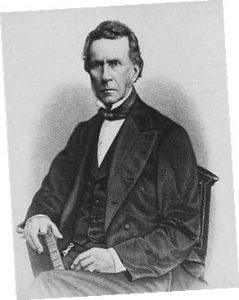
Upper Case Editorial
WHAT’S IN A (NICK)NAME?
The nickname on your license plate dates back to a speech delivered at the 1876 Centennial Exhibition in Philadelphia. Abraham Browning (below) of Camden described New Jersey as a “Garden State”—an immense barrel filled with good things to eat and open at both ends. Benjamin Franklin made a similar observation decades earlier.

Courtesy of Rachel Weston
JERSEY TOMATOES
New Jersey farmers have been growing tomatoes since the 1920s. Now, there are hundreds of varieties. But the quintessential Jersey tomato, the Rutgers 250 (named for Rutgers University’s 250th anniversary), is considered delicious enough to bite into like a piece of fruit so the sweet juice drips down your chin. Rutgers tomatoes, among the most popular Jersey  varieties, were once commercially grown specifically for canning—think Campbell’s Soup in Camden. The seeds can still be purchased for growing in your own garden.
varieties, were once commercially grown specifically for canning—think Campbell’s Soup in Camden. The seeds can still be purchased for growing in your own garden.
Editor’s Note: Eric LeVine demonstrates his commitment to sustainability, his community and his customers through education. Look for classes this spring and summer on farm-to-mouth cooking on his website, www.chefericlevine.com.
“There’s a new chef in town…Christopher Albrecht, a protégé of Tom Colicchio…and his is the ultimate farm-to-table future.”
By Andy Clurfeld
THE RYLAND INN
115 Old Highway 28, Whitehouse Station
Phone: (908) 534.4011
Reservations recommended. Major credit cards accepted. Open from 5 to 9 p.m. Tuesday through Thursday, 5 to 10 p.m. Friday and Saturday, 11 a.m. to 2 p.m. for Sunday brunch and from 4 to 8 p.m. for Sunday dinner. Prices: Snacks and cheese: $6 to $21. Appetizers: $13 to $22. Entrees: $22 to $54. Side dishes: $9. Desserts: $12. Five-course tasting menu: $75; $120 with wine pairings; five-course vegetarian tasting menu: $65; $110 with wine pairings.
The Ryland Inn is a grand old gal. She sits on a sidecar to Route 28 in Whitehouse Station, set back from the bustle of the highway and possessing an elegance that only the most effective facelifts can provide. Oh, she’s had work done, of that you are sure. Yet if you remember her from the old days—say, back in the 1970’s—when pioneers to this once-agrarian part of Hunterdon County used to congregate at the bar, you’ll feel at once at home with your memories and in awe of the rejuvenating renovations.
Ryland had a rebirth in the 1990’s courtesy of Craig Shelton, a chef who brought it four-star fame and, eventually, a James Beard Award. The kitchen has been manned by a Who’s Who of Garden State chefs (James Laird and Anthony Bucco, to name a couple) and visited by luminaries of all stripes: Ronald Reagan dined there, as did the food cognoscenti from Gourmet, who put Shelton on the cover of the magazine in October 1997.

Photography courtesy of The Ryland Inn
Flash forward to now: There’s a new chef in town, and his is the ultimate farm-to-table future. Christopher Albrecht, a protégé of Jersey son and “Top Chef” star Tom Colicchio, is the definition of the chef-of-today. Albrecht talks soil before he talks anything else in the culinary processes. “The most flavorful bounty any garden or farm produces is not an accident,” the chef says in literature presented with the check to every table at Ryland. “It’s a direct reflection of the condition of the soil.”
Ryland has its own farm and Albrecht, best known from his years at Eno Terra in Kingston, also plucks primo ingredients from more than 20 regional farms, food purveyors and producers to make up his evolving tasting menus, a la carte bill of fare and nightly specials.
Albrecht merges ingredients of the micro-seasonal moment with simplicity of presentation, function driving flourish—such as the pop of crunch the deep-rose pomegranate seeds give the pitch-perfect thin slices of opa supported by tiny leaves of cilantro and celery, sour-slightly sweet  grapefruit in a “snack” of crudo. There is the best dish of the night, a cauliflower-and-mushroom cassoulet, which we begged a portion of from the vegetarian tasting menu. It’s not-pretty brown-and-beige, but it is pure soul food, with flageolets and black-eyed peas providing the base, fennel and leeks the counterpoints, and the starring vegetables the binding flavors.
grapefruit in a “snack” of crudo. There is the best dish of the night, a cauliflower-and-mushroom cassoulet, which we begged a portion of from the vegetarian tasting menu. It’s not-pretty brown-and-beige, but it is pure soul food, with flageolets and black-eyed peas providing the base, fennel and leeks the counterpoints, and the starring vegetables the binding flavors.
The tortellini stuffed with a trio of pulled game meats—duck, rabbit and pheasant—suffers from tough, hard-in-parts pasta. However, the smoked game broth, streaked with shards of ricotta and shreds of Swiss chard, is so divine, I lift the bowl to my lips to drink down every ounce. But someone on the line didn’t watch the pot as the tortellini boiled!
A special of quail stuffed with raisin bread, olives and fennel was stunningly salty, both in its breast meat and the skin of the bird. The red corn grits that support the sweet Nantucket bay scallops taste, well, gritty, but when you connect the grits to the scallops with the grilled radicchio, a light bulb goes off. The bitterness of the radicchio, soothed by the red wine reduction and the richness of bone marrow, bridges shellfish and grain. It works. You eat, and you eat more.
 Talk about bridges: Fat pappardelle, fortified by squid ink and midnight black, is given the all-luxe treatment with a Bolognese of venison, the warmth of chocolate and the infusing heat of Aleppo pepper. It’s another eat/eat more dish. I didn’t feel similarly about the braised and roasted beef duo, with torpedo-shape onions sitting atop the shredded meat and a thick oval of textbook medium-rare beef standing solo on the plate astride the potato-Swiss chard gratin. All good, fine enough, but the heartstrings felt no tug.
Talk about bridges: Fat pappardelle, fortified by squid ink and midnight black, is given the all-luxe treatment with a Bolognese of venison, the warmth of chocolate and the infusing heat of Aleppo pepper. It’s another eat/eat more dish. I didn’t feel similarly about the braised and roasted beef duo, with torpedo-shape onions sitting atop the shredded meat and a thick oval of textbook medium-rare beef standing solo on the plate astride the potato-Swiss chard gratin. All good, fine enough, but the heartstrings felt no tug.
If we saw another charcuterie board pass by, we were going to pitch a fit. Instead, we interrupted the dinner’s flow by ordering one. There’s not just the de rigueur salumi on board, but a riveting chicken-liver mousse and a classic French rolled paté that defines melt-in-mouth sensibilities.
If you’ve never experienced viognier in its Condrieu incarnation with paté, do so here: Though Ryland’s wine list needs to pay better attention to Albrecht’s predilections for sauces, seasonings and spices, the 2011 Domaine Faury Condrieu is a bottle that can take you through the charcuteries and many, many dishes here.
 The kitchen needs to take another pass at its maple flan dessert. The flan, thick, pasty and not maple-y, tasted like canned pumpkin pie filling. Its accompanying citrus salad, spiked with Earl Grey, sported unripe segments of grapefruit, while the funnel cake (which looked, oddly, like a fried soft-shell crab) was heavy with batter and oily. And the oval scoop of whipped cream was overwhelmed by cinnamon. In another finale, the chocolate trio, the chocolate-caramel tart was afflicted with un-dissolved sugar and mighty grainy, a flaw neither the hot chocolate nor the icy semifreddo could mitigate.
The kitchen needs to take another pass at its maple flan dessert. The flan, thick, pasty and not maple-y, tasted like canned pumpkin pie filling. Its accompanying citrus salad, spiked with Earl Grey, sported unripe segments of grapefruit, while the funnel cake (which looked, oddly, like a fried soft-shell crab) was heavy with batter and oily. And the oval scoop of whipped cream was overwhelmed by cinnamon. In another finale, the chocolate trio, the chocolate-caramel tart was afflicted with un-dissolved sugar and mighty grainy, a flaw neither the hot chocolate nor the icy semifreddo could mitigate.
So we have Ryland past, Ryland of a rebirth era and, now, Ryland looking ahead. With Albrecht, this nationally known landmark has the right stuff for a bright future.
It’s up to the folks who brought The Ryland Inn to its present, owners Jeanne and Frank Cretella, to let this chef hold sway.
SUPPORT SYSTEM
 I wondered if Albrecht was getting the proper support in the kitchen with a couple of dishes (quail over-salted, tortellini undercooked). On the whole, the dishes are well-conceived. But, is there a notch that’s not yet been kicked up? I think so.
I wondered if Albrecht was getting the proper support in the kitchen with a couple of dishes (quail over-salted, tortellini undercooked). On the whole, the dishes are well-conceived. But, is there a notch that’s not yet been kicked up? I think so.
Ryland deserves, Albrecht deserves and diners deserve service that is head-and-shoulders above the crew on the floor of these stately dining rooms. The front-of-the-house staff needs a crash course in propriety and how to serve in a fine-dining setting.
This isn’t about a miscue here and there, but across-the-board fundamentals. Information about specific ingredients in dishes is given incorrectly, knowledge about beverages (particularly wine) is lacking, and basic tableside etiquette ignored, with diners’ conversation routinely interrupted and the practice of being watchful from a discreet distance seemingly not taught.
You’ve seen Hank Azaria’s face a hundred times and heard his voice a thousand more. Or maybe ten thousand more. Fans of The Simpsons know him as the man behind the voices of ill-tempered bartender Moe Syzslak, gluttonous police chief Chauncey Wiggum, sad-sack Comic Book Guy, hillbilly Cletus Spuckler and America’s favorite convenience store clerk, Apu (“Thank you come again”) Nahasapeemapetilon. Azaria’s over-the-top film roles include fork-flinging superhero The Blue Raja (Mystery Men), 1950s sports legend Patches O’Houlihan (Dodge Ball), megalo-maniacal pharaoh Kahmunrah (Night at the Museum: Battle of the Smithsonian) and inept houseboy Agador Spartacus (The Birdcage). To this long list of indelible characters add Jim Brockmire, the title character in IFC’s Brockmire, a new comedy co-starring Amanda Peet. The show follows the travails of a legendary announcer banished to the bush leagues after a profanity-filled on-air meltdown. Gerry Strauss talked to Azaria about what it takes to slip into the shoes of one unique character after another…and what makes his newest role the culmination of a long, personal journey.

Courtesy of IFC
EDGE: You have a particular talent for creating scene-stealing characters. How does that differ from being an actor who inhabits a character for months or years?
HA: It’s fun. It’s not boring. You do get to switch things up. Even if it’s as simple as going back and forth from comedy to drama and, let alone going from a guy who’s kind of unhinged, to somebody who’s rather sweet, then to somebody with a Latin accent, then to a guy in law enforcement. Whatever it is, it’s fun.
EDGE: Is it a way to learn about the world?
HA: It is. As I take on a different role, I tend to learn about what that person would really be like. It’s a great way to discover how different people live and think. That’s the easy part for me. I became an actor because as a teenager, I was very insecure and did not want to be myself. I wanted to be anybody but myself. I discovered that, in order to do the craft of acting well, you have to reveal yourself to an extent. Still, I like that chameleon aspect of what I do. Vocally, that’s easy for me. A lot of times, I feel like if I find the way a character sounds, I also instinctively know how he thinks and feels. I don’t know why that is.
EDGE: Jim Brockmire is an old-school, throwback sports announcer. Do you tend to gravitate towards characters that harken back to the past?
HA: Oh, for sure. That’s like a major theme of Brockmire. Old-school dude in a modern world. I grew up watching and listening to a lot of those voices. I’m 52, so my memories go back to about 1969, 1970, and to an extent those guys were still around. A lot of them had very distinct voices. Any distinct voice, any vocal anything, really made a huge impression on me. And still does. I always was asking myself, “Why are they talking like that?” I was always noticing the way folks sounded, and asking why they sound like that. Those baseball announcers especially. I’d wonder, Why is this the voice that delivers sports and commentary and information? Then I started wondering if these guys were like this in their private lives, if they still sound like this when they’re having sex, when they’re eating dinner, when they’re wasted. That was the comic premise of Brockmire that we started with—as well as the fact that these guys can basically say whatever they want on the air, as long as they get the count right. Then it kind of grew into what you just said, which is how does an old-school guy handle the modern world? That became an even more important aspect of the show.
EDGE: When did you begin working on the Jim Brockmire character?
HA: Like I said, it was a voice I was particularly obsessed with as a teenager. By the time I was in my 20s and working professionally as an actor, it was at least in the back of my mind, like This voice belongs somewhere comedically—it should be something. It was a character I did for my friends at poker night all through my life, just announcing whatever was going on in some kind of foolish way. About 20 years ago, in my early 30s, there was a movie script I was working on that never got off the ground. Not about a baseball announcer, but I think it was about a telemarketer who talked with this kind of announcer voice. Then I did it as a Funny or Die short about eight years ago, with the idea that, maybe if people liked it, we could develop it into a TV show or movie. That’s always the plan, and it never happens. But it actually did with this one.
EDGE: I suspect that people might be surprised to discover that Brockmire is a lot more than a comedy about a guy with a hilarious way of speaking. It’s a show with tons of heart, as well as a dark undertone. How do you strike that kind of balance?
HA: It’s a few things. And thank you for saying that. I agree. First, I have to acknowledge Joel Church-Cooper, who is our show runner and wrote most of the episodes himself. Joel’s got the ability to not only understand a guy like Jim Brockmire on the surface, but also to commit to this fish out-of-water, old-school alcoholic has-been in a modern world. He really grasps those things and writes them really funny and really poignantly. That’s what I think you’re responding to: He’s a real guy. It’s kind of my shtick. I like to find strange, vocal personages that just sound funny to me—and the game I like to play is Now let’s fill that person in and make him real.
EDGE: How do the characters you play on The Simpsons come to life? How does the collaboration between voice actors and animators play out?
HA: In animation, the voices are recorded first—whether it’s The Simpsons or whatever last Pixar thing that you saw—you record it like a radio play. They edit together a soundtrack that they think works, and then they do an animatic, which is a pretty cool black-and-white sketchy version of the show or the movie. That gives them a feel for how it’s playing. What we usually do next is write based on that animatic, then do some re-recording based on that animatic, and finally send it off and start the actual process of animating. Once that color animation comes back, you get another round of re-writes as the thing starts really coming together.
EDGE: Is it difficult to re-write animated characters?
HA: It’s pretty easy because you don’t need to go and shoot again in locations, you just need to change lip flaps of characters mouths moving, or add a scene, or whatever it is. During the first 10 or 15 years of The Simpsons, the voice cast was always all together recording. We got to know each other intimately, each other’s timing and whatever. The last bunch of years have changed. I live in New York now, so I usually record on my own. I feel like I work better recording on my own because they’re only focused on me while I’m recording. I can give a lot more choices. And having spent 15 years learning everyone’s timing, we all knew what the other one is going to do before they do it.
EDGE: I know you’ve said that most of your voices and characters are derived from actual people. What’s it like when you run into those people after the fact?
HA: There have been times when I’ve worked with somebody who I did an impression of, and they sort of get wind that you do an impression of them, and they say, “Let’s see it! Let’s hear it.” That’s a highly embarrassing, awkward moment in your life. But no one’s ever come to me like, “Hey, you’re doing my voice there, aren’t you?” I once did a character voice that was based on a guy I grew up with, very distinctly. He came up to me and mentioned that he liked the character, but didn’t realize that it was based on him. That made me laugh. There’s another character, Snake, on The Simpsons that’s based on a guy I went to college with. I said that publicly, and he got a big kick out of that fact. I spoke to that guy recently, and he sounds nothing like how I remembered him! I think it was really only when he was wasted that he sounded like Snake.
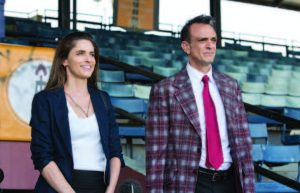
Courtesy of IFC
EDGE: Both of your parents were interested in the entertainment industry. Did growing up in that environment set the stage for your own interest in becoming an entertainer?
HA: Yeah, it definitely made an impression on me. The culture of the house was to see what’s going on in TV, music, film, and stage. [My parents] were major enthusiasts of everything, from whatever sitcom was popular to the opera. They really were genuinely all over it. When you’re a kid, you just think that’s what everybody does, but my parents were extreme in their appreciation of entertainment. But back then, kids were pretty much left alone. It’s not like today. You pursued what interested you, and I was majorly interested in entertainment and sports. My parents weren’t all that sports-oriented, but I was very into that. New York’s a great sports town, it’s got everything. I grew up in Queens back when the Jets and the Mets played at Shea Stadium. We lived very close to Shea, so it was like we had a couple of our own teams, not to mention the Knicks. I don’t know if it was particularly a New York thing. Actually, the truth is that it was a TV thing. I was mostly raised by a television set. I watched whatever was on it, whether it was The Brady Bunch, a Mets game—it almost didn’t make any difference to me. It was always going to be the television set.
EDGE: And you were a gifted mimic.
HA: Yeah, big time. I am a mimic, quite literally a vocal mimic. That came too easily to me. What was difficult about acting was being yourself in front of people, revealing your honest emotions. I didn’t like that at all. I had to actually learn to do that. It didn’t come easily to me. I really needed to go to class for that. It was easier for me to learn improvisational comedy skills than it was to learn to be myself in a dramatic scene. But the better you are at that, the funnier you are, I think.
EDGE: You and Oliver Platt started an acting troupe after graduating from Tufts. Was live theater terrifying for you?
HA: The short answer is Yes. I was profoundly uncomfortable acting, really. When I look back, I’m kind of amazed I was so driven to do it and stayed with it. I loved it so much. I guess I saw that I was good at it on certain levels, so I felt compelled to keep doing it. But it took me a long time to relax. It’s amazing I did as well as I did, given how tight I was well into my 30s and 40s. I really feel like it’s only in the last five or 10 years that I’ve calmed down on camera and in front of people.
EDGE: Brockmire is launching on IFC at a time when the bar for quality television is higher than ever. What do you make of this industry?
HA: As a fan of television, which I am—and somebody who’s lucky enough to work in television—I’m so thrilled to see this second Golden Age of Television, this evolution into incredible creative freedom. Freedom of language. Freedom to curse a blue streak. Freedom to talk about whatever you like. Places like Amazon, Netflix, HBO, Showtime, or via cable, FX. IFC said, “Let’s get creative people in here and let them do what they want to do with the show. Let’s let them try what we think is a really good idea, with really smart, funny people doing it. Let’s leave them alone to do what they want to do.” It’s been thrilling. Especially thrilling for me, who is so frustrated whenever I’ve tried to bring things to network. It gets watered down. It gets compromised. I have incredible admiration for anybody who makes a quality network show, given the corporate and creative structure.
EDGE: Is it a lot of pressure or a lot of fun having the freedom to do what you want to do?
HA: It’s so much fun. They’ll say, “You know what? These are our suggestions. Take what you like, leave the rest. If it makes sense to you, do it. It’s up to you.” It’s just a tremendously great thing. It’s why awesome television has been getting made throughout the last decade.
What’s the ideal mindset for someone whose future includes significant changes to their body and health?
Progress. That is the key. If you expect perfection, you only set yourself up to fail. Any progress, no matter how minimal, is a huge success. You have to understand that, not only are you not stagnant, but you are not going backwards. And that’s huge.
What’s the greatest mental roadblock to making healthy changes?
Self-destructive behavior. When we engage in self-destructive behavior, it isn’t because we are weak, lazy or dumb. It’s because it affords us something—control, comfort, connection, et cetera. So giving up these bad habits represents a “loss” in another part of one’s life. That’s why it’s so difficult to do. And that’s why I try with my new app to offer a sense of community and support for people, along with personalized meal plans and exercise regimens. The app has been a year in development. It literally allows me to be your personal coach, trainer, and nutritionist.
What were your goals in developing the new app?
Making fitness and healthy eating affordable, accessible, fun, customizable and effective. There are over 550 different exercises, and hundreds of different workouts with different timeframes for people of all fitness levels. And it’s completely interactive. You can swap out exercises to personalize your workouts, increase or decrease the intensity at any time and it will respond.
What’s a proper balance between going for immediate results and the “long game” in achieving fitness goals?
Short-term wins add up to long-term successes. It’s about taking one step at a time.
What types of goals do you set for yourself?
It depends. It could be personal improvement, like working on being more vulnerable. It could be a fitness goal, like running a 10K. It could be a business benchmark. The key is to keep moving forward and, even when we fail, learn from the past and look to the future. EDGE
Editor’s Note: The new Jillian Michaels app is available on her web site, jillianmichaels.com. Gerry Strauss conducted this Q&A with Jillian. Be sure to check out his interview with Hank Azaria, star of the IFC series Brockmire, on page 33.






